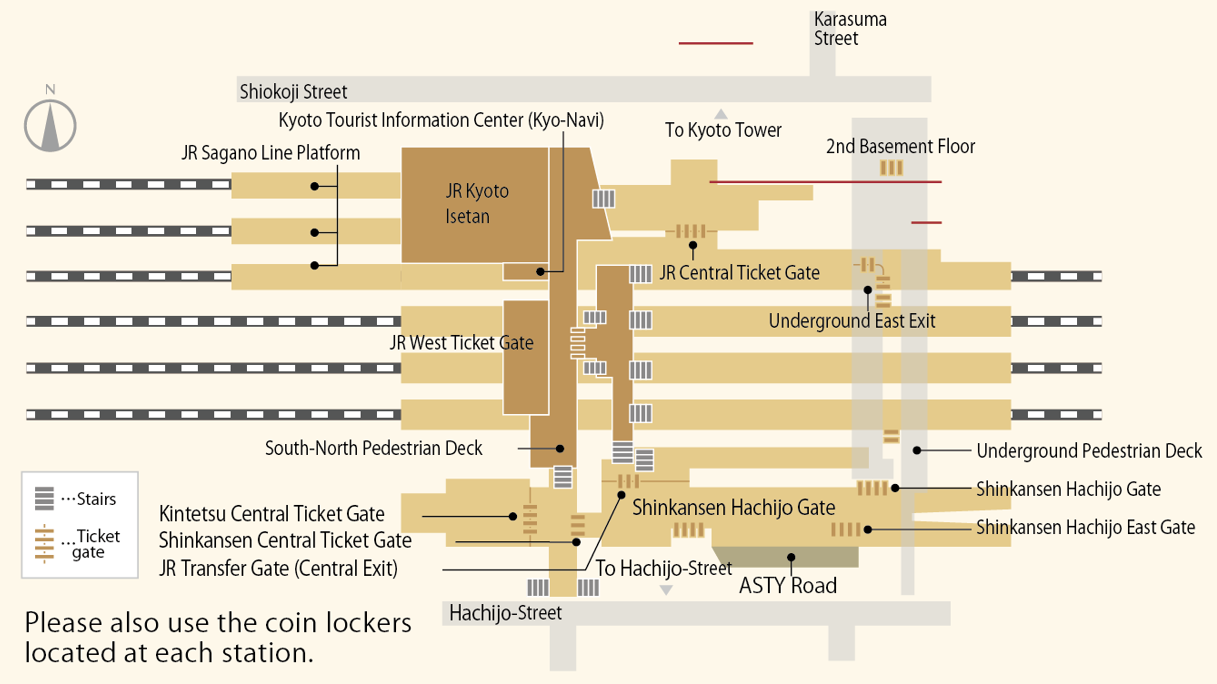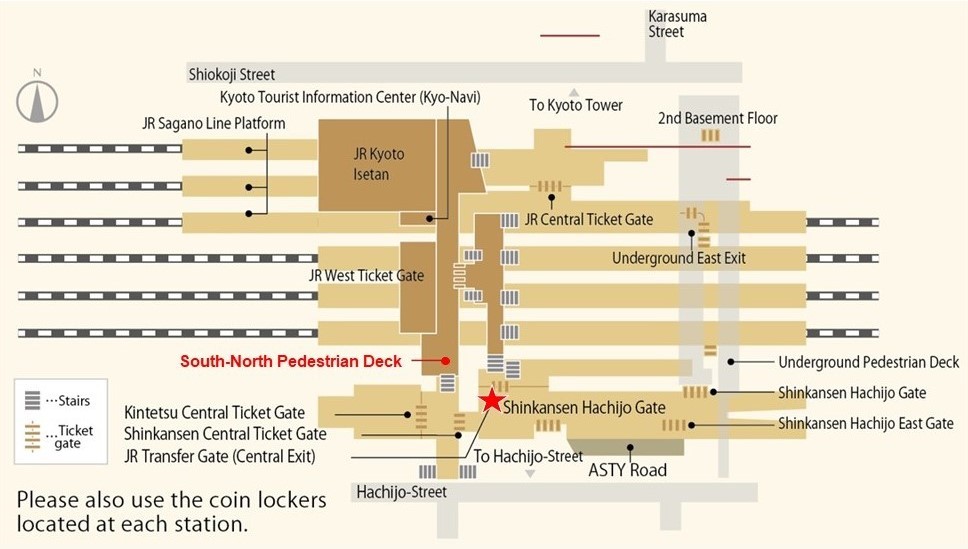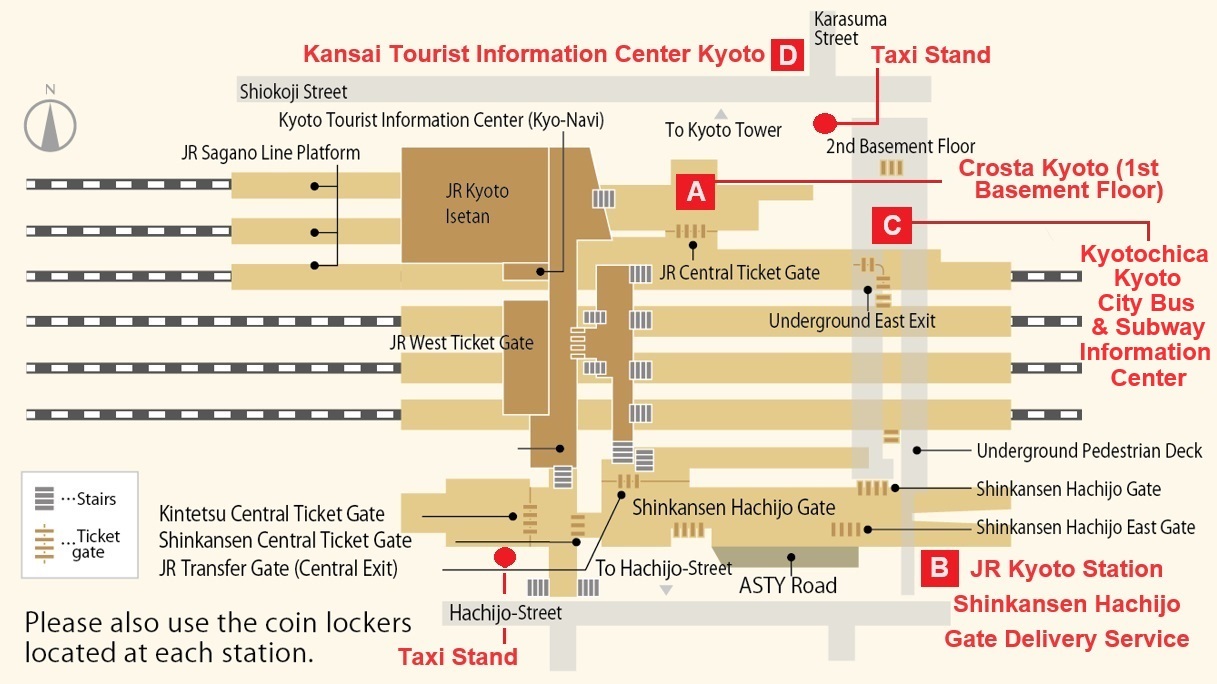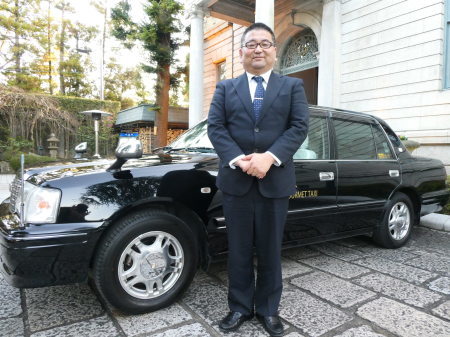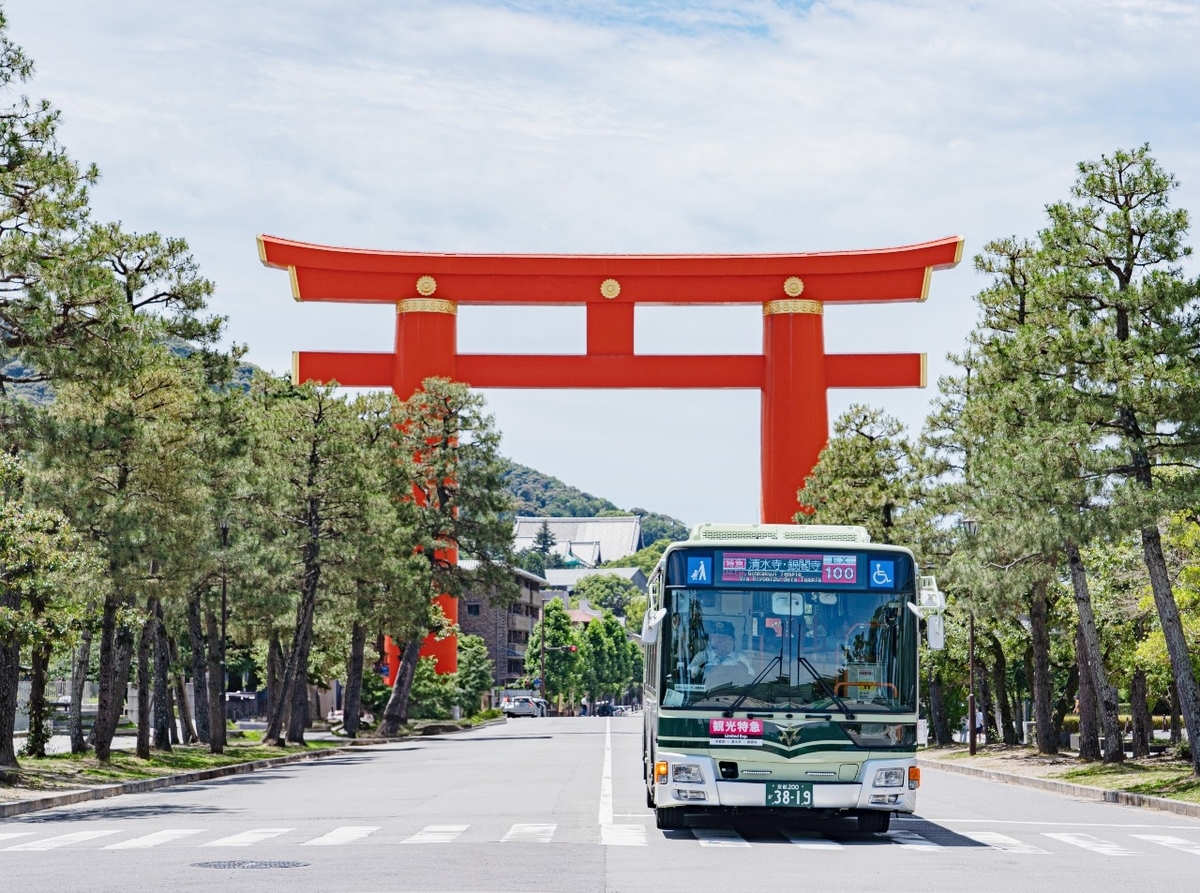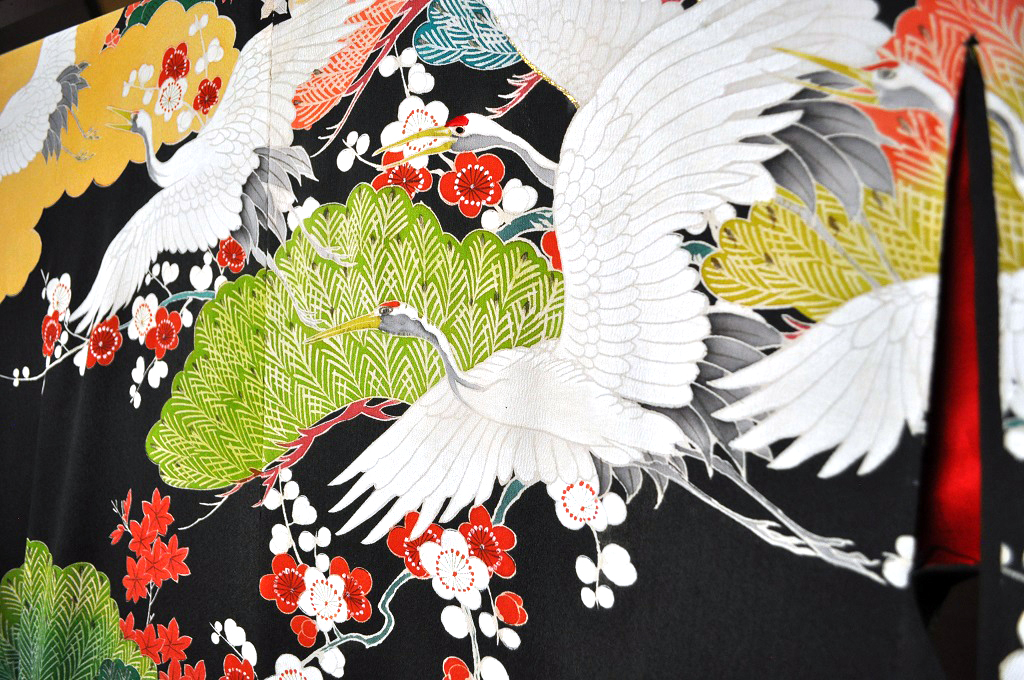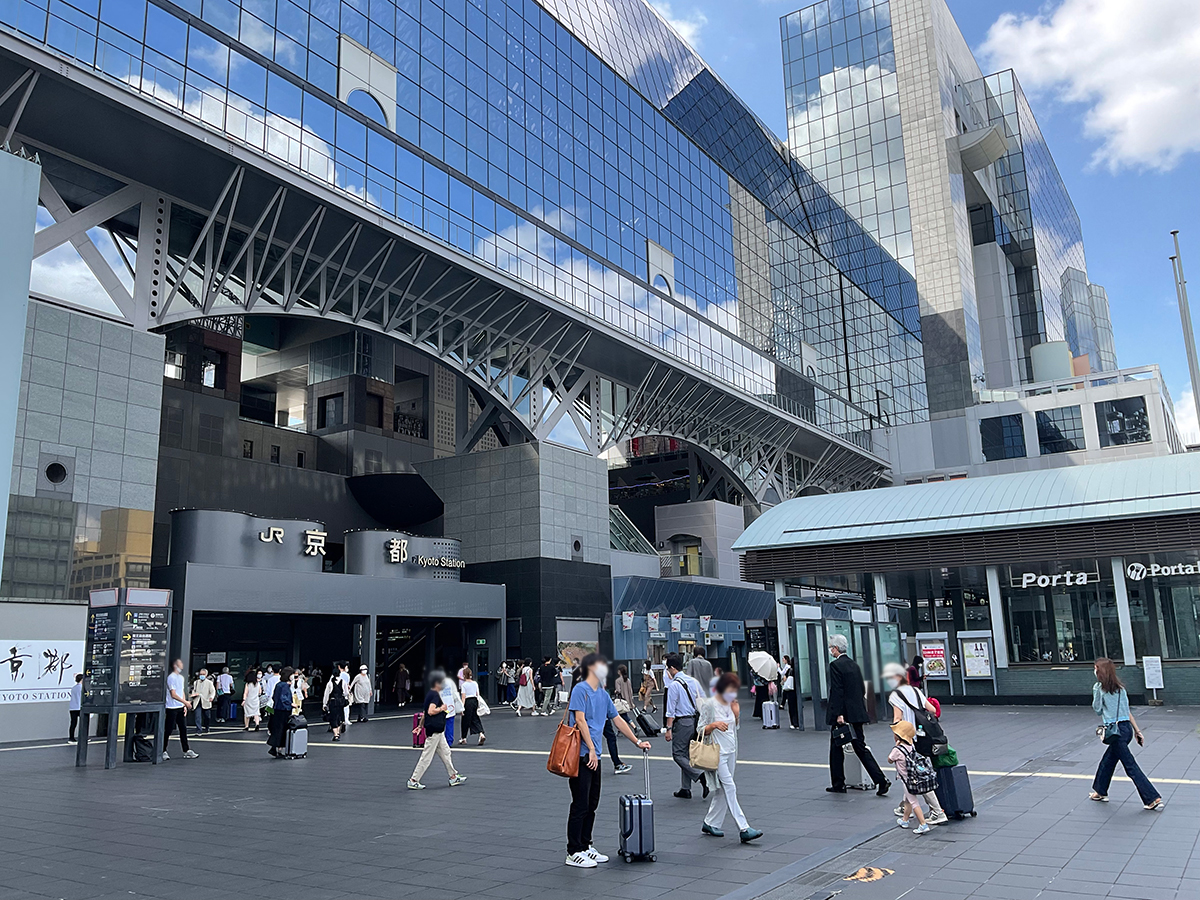
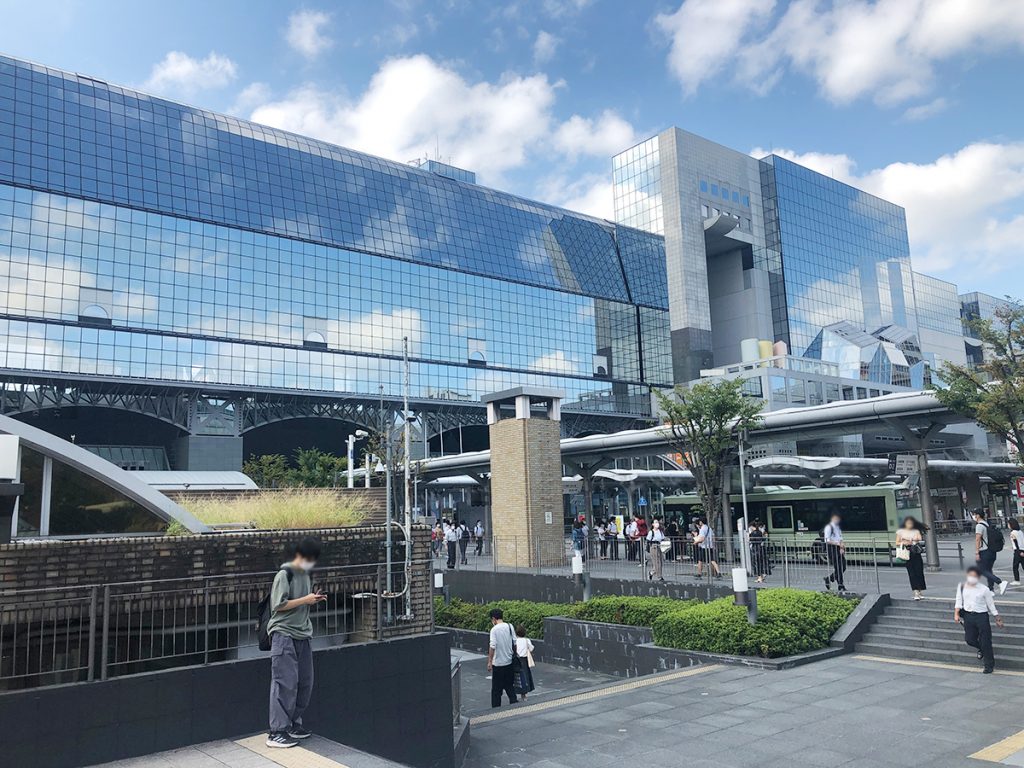
Kyoto Station, known as the gateway to Kyoto, is one of the most frequented terminal stations in Japan, handling a massive number of passengers every day. It’s the first stop for tourists who make their way here via public transit, and with numerous hotels and commercial facilities within walking distance, many people pass through every day. However, the station is a bit complicated, and even locals get lost in it from time to time.
So now, we’ll take a complete look at how to get around Kyoto Station. Here are some handy tips on how to make your way through Kyoto Station with ease. Remember these and you’ll never get lost again!
Crucial First Moves: What Do You Do After You Get Off the Shinkansen? (Basic Info)
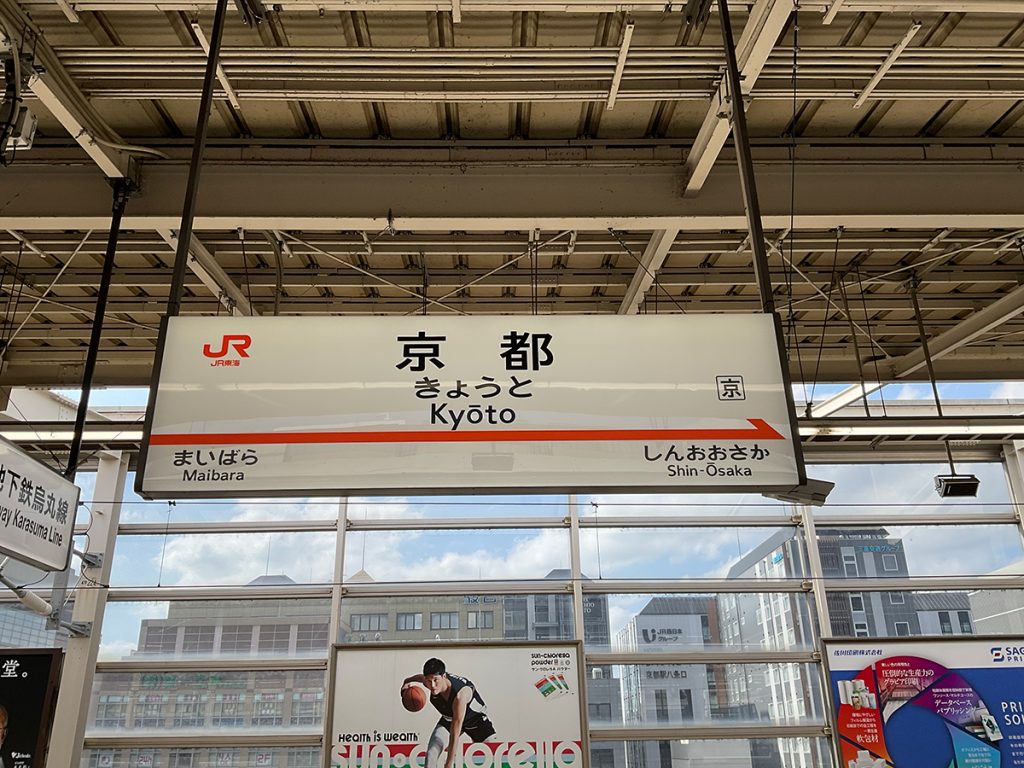
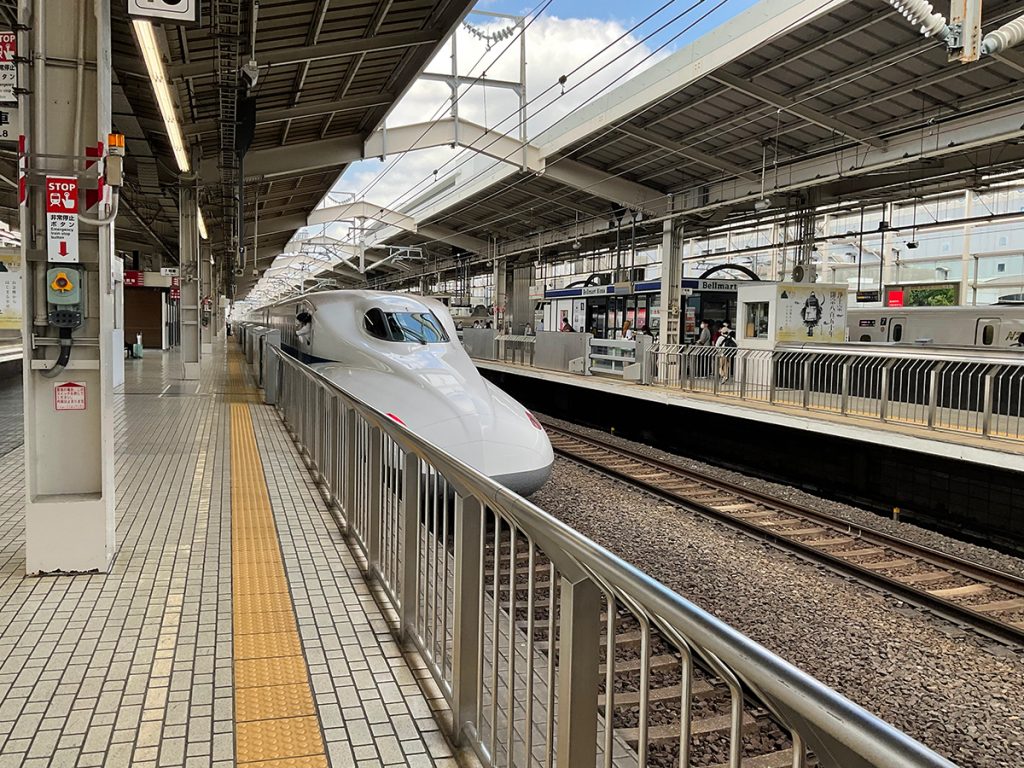
You’ve arrived at Kyoto Station from the direction of Tokyo and Nagoya, and stepped out onto the platform. The announcement of “Kyoto, Kyoto” echoes through the air, and the townscape of the ancient capital looms before you.
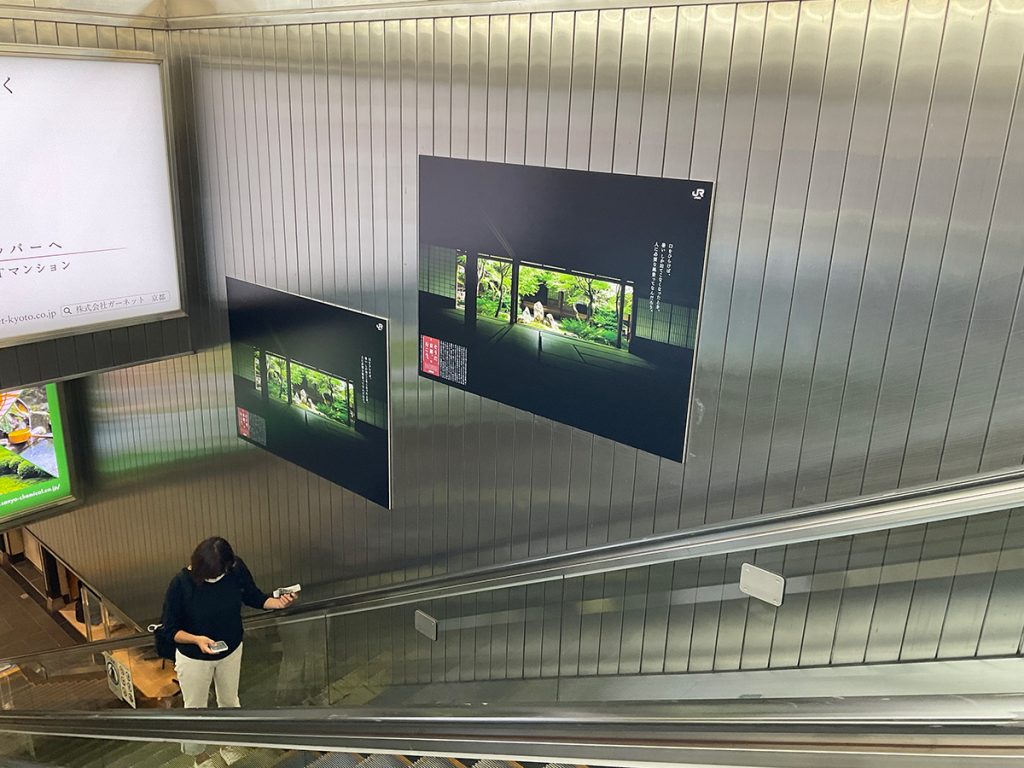
A poster that reads, “Yes, let’s go to Kyoto.” which is not often seen in the city of Kyoto itself.
On the wall of the escalator as you head down from the platform to the concourse, you see a JR Tokai poster that reads, “Yes, let’s go to Kyoto.” You realize at this moment, “I’ve made it to Kyoto!” and the first thing on your mind is “I wanna go out and see it now!”
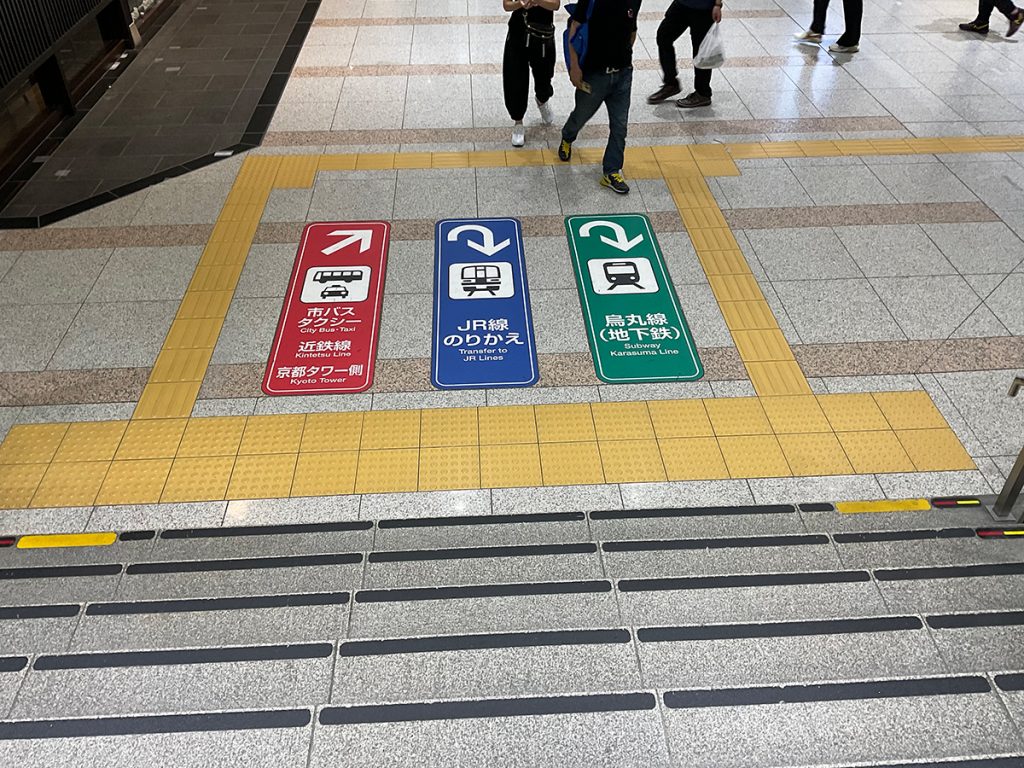
Be sure to pay attention to the information right at your feet.
But first, let’s stop and take a breather. It’s important to stay calm and pay close attention to your surroundings rather than just follow the flow of people. There are two things to keep in mind at this point:
Tip 1: There are three main types of public transit departing from Kyoto Station:
(1) Local JR lines, private railway lines, etc.
(2) Subway Karasuma Line
(3) Buses
It’s a good idea to know in advance, with the help of route maps, timetables, transfer searches, and so on, which mode of transportation is best for getting to where you want to go.
Tip 2: The north side where Kyoto Tower is located is the “Central Exit”
Kyoto Station has two large exits that lead outside: one on the north side called the “Central Exit”, and another on the south called the “Hachijo Exit”. These are similar to the “Marunouchi Exit” and “Yaesu Exit” at Tokyo Station, and are often seen on the information displays in the stations as well as on station maps. However, first-time visitors to Kyoto may not have a clear understanding of which exit is closest to where they are at the time. The “Central Exit” is where boarding areas for the buses and taxis that travel around the city are gathered, and it’s often used as a meeting place for people, so it’s a very useful location. The Central Exit is the one where Kyoto Tower is, but unfortunately the tower is not visible from inside the station. That’s why you should keep an eye out for signs leading to the “Central Exit”.
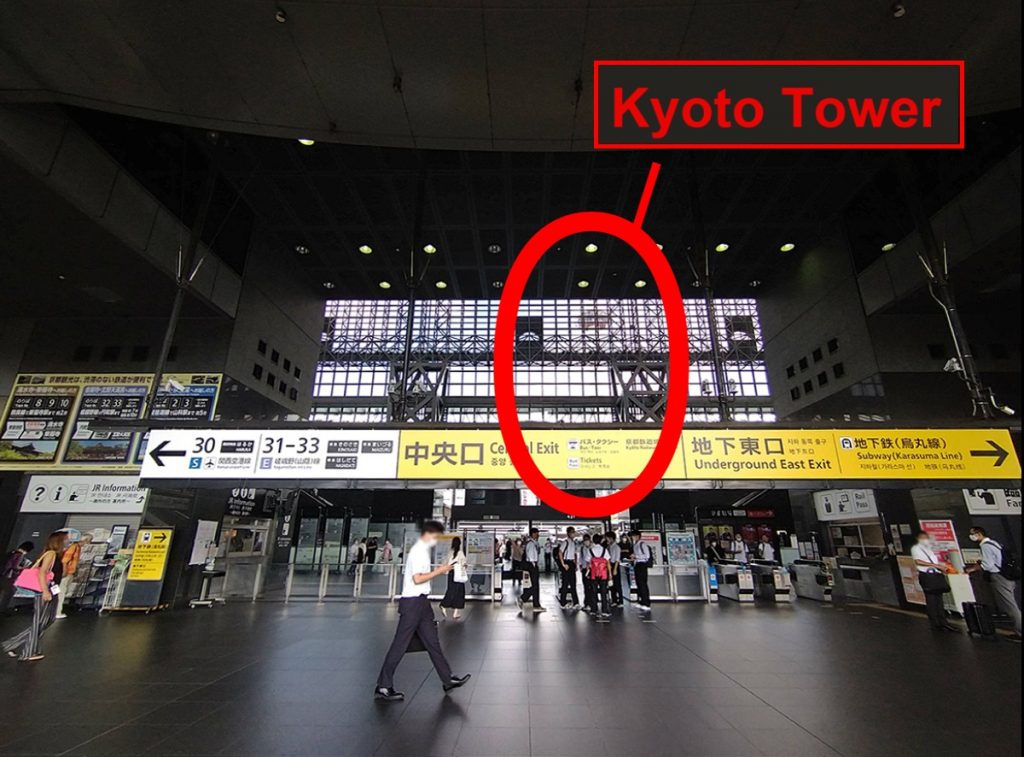
As you approach the Central Exit, you can start to see Kyoto Tower through the glass!

There is a “Shinkansen Central Exit” that serves as the exit of the Shinkansen concourse, but this is different from the “Central Exit” of the area of Kyoto Station for the local train lines. Conversely, that exit will lead you to the “Hachijo Exit” instead.
Now let’s go over each route step by step. First, let’s cover how to transfer from the Shinkansen to JR lines or other railways.
Transferring to other train lines (local JR lines and Kintetsu)
The main JR lines that depart from Kyoto Station are detailed below. These local JR lines are a convenient way to get to places such as Saga-Arashiyama, Fushimi Inari, Uji, Shiga, and Osaka. However, the platform number may change depending on the time of day and other factors, so be sure to check the departure information when you’re there.
For Yamashina, Shiga Platforms 0, 2, 3 Biwako Line, Kosei Line
For Takatsuki, Osaka Platforms 4, 5, 6, 7 Kyoto Line (Tokaido Main Line)
For Saga-Arashiyama Platforms 31, 32, 33 Sagano Line (San-in Line)
For Inari, Uji Platforms 8, 9, 10 Nara Line
For Kansai-airport Platforms 6, 7, 30 Limited Express Haruka
Tip 3: There is a multipurpose restroom and elevator at the “Transfer to JR Lines (Central Transfer)” exit
At the Shinkansen concourse, there are two exits labeled “Transfer to JR Lines” that you can use to transfer to the local JR Lines.
・Transfer to JR Lines (Central Transfer)
→ You can transfer to any of the local JR lines.
・Transfer to JR Lines (East Transfer)
→ Recommended for transferring to the Kyoto Line (Tokaido Main Line), Kosei Line, and Nara Line.
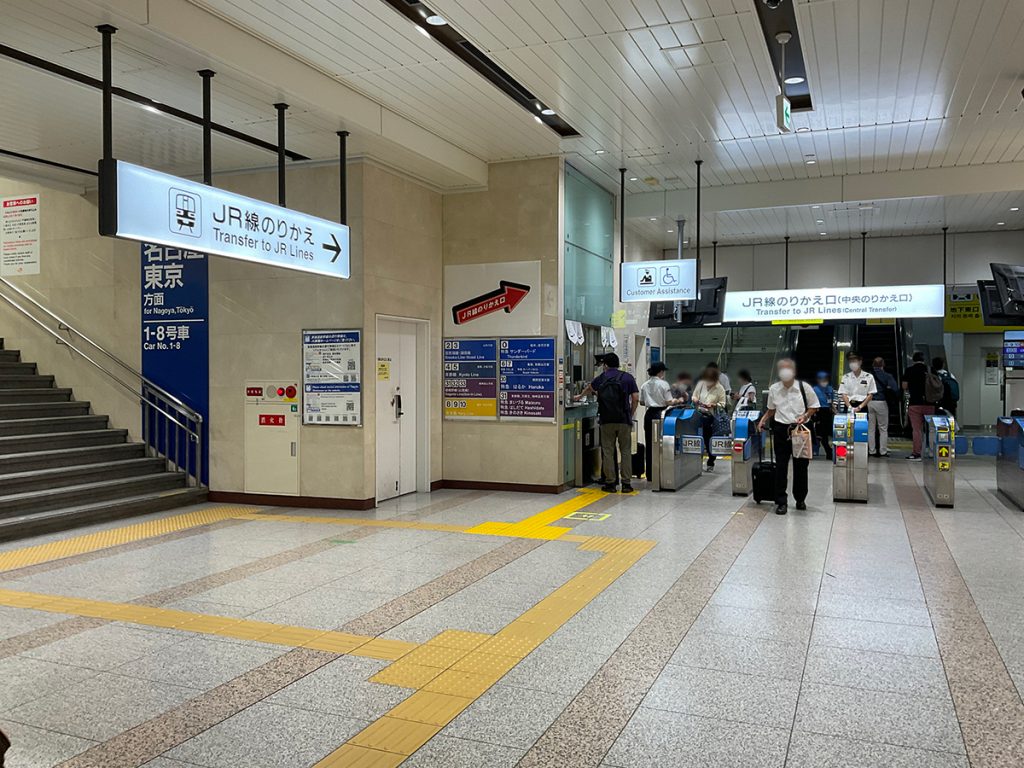
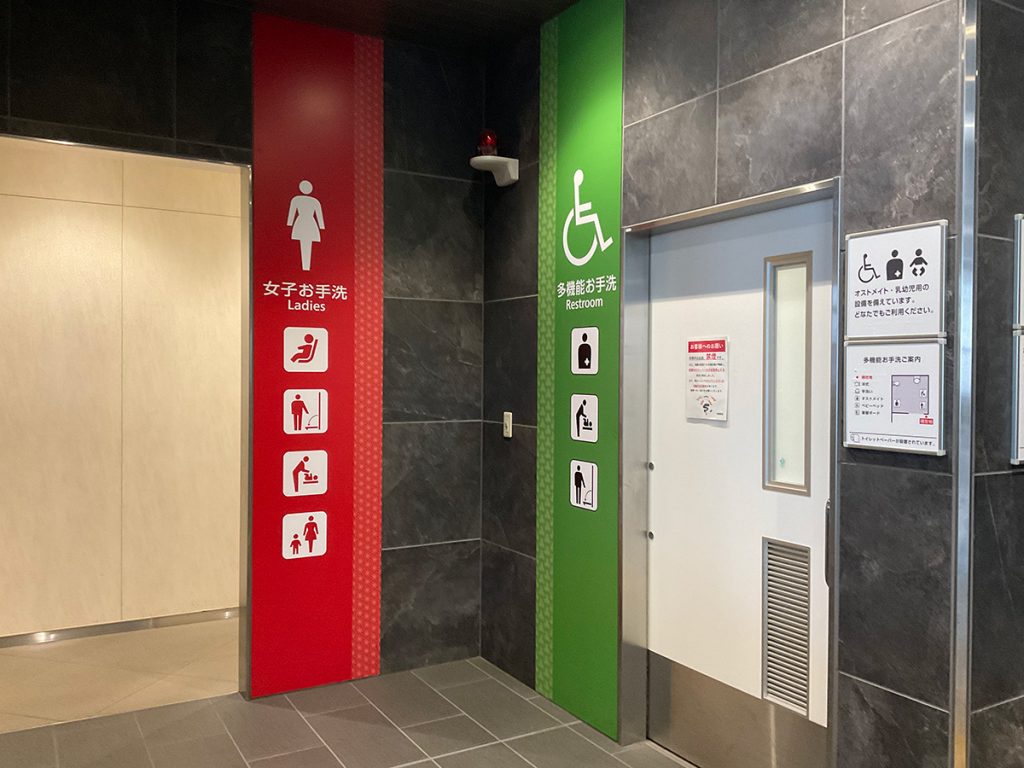
The exit labeled “Transfer to JR Lines (Central Transfer)” has escalators, elevators, and a multipurpose restroom just outside of it, making it a good choice for elderly travelers or families with children.
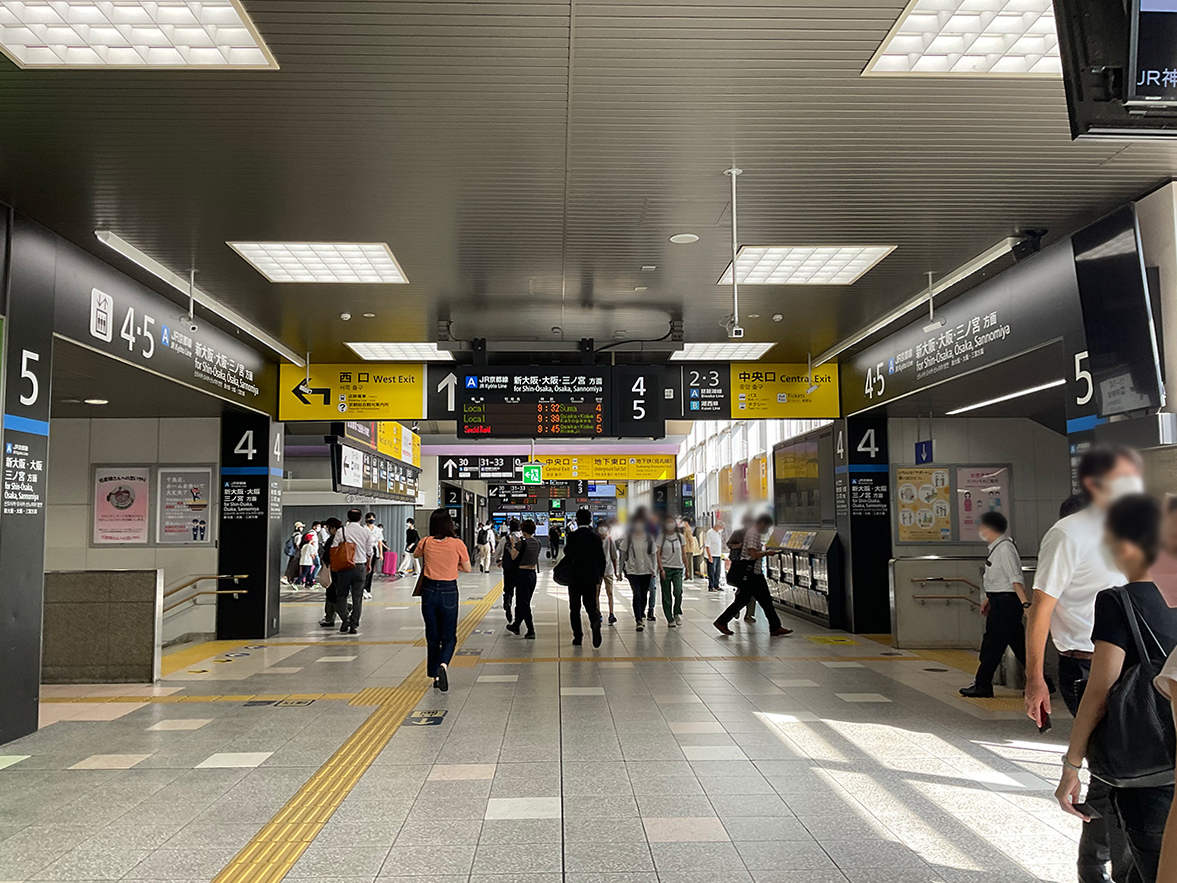
To transfer to the local JR lines, go out through the “Transfer to JR Lines (Central Transfer) exit”, then go through the passageway inside the ticket gates.
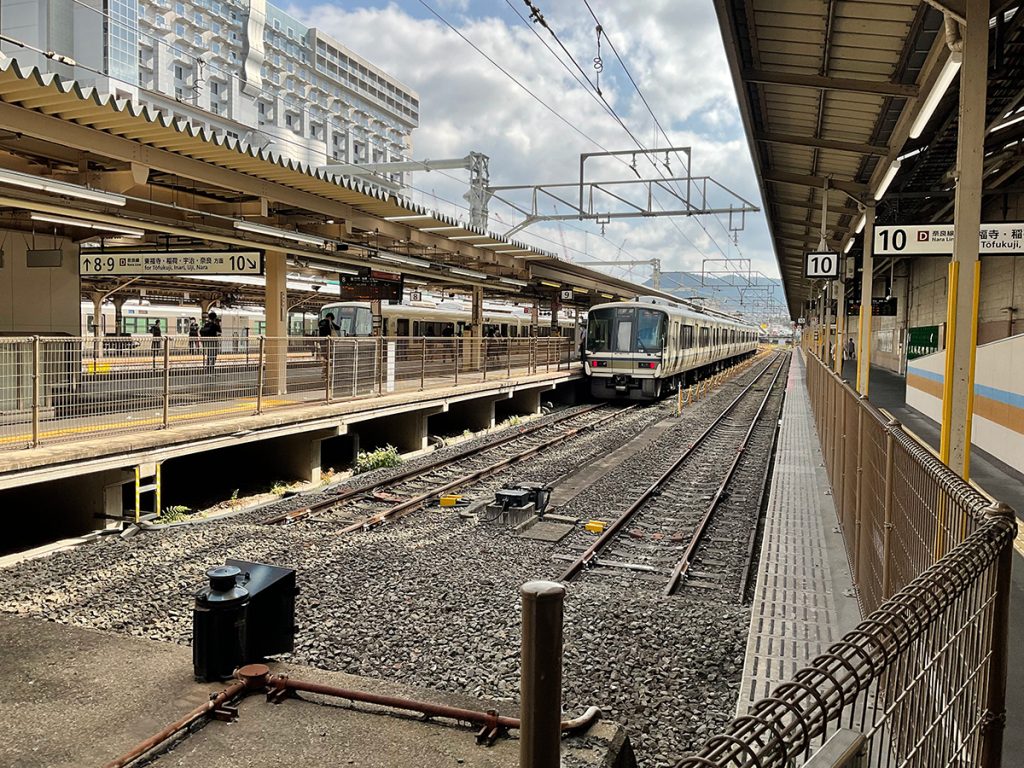
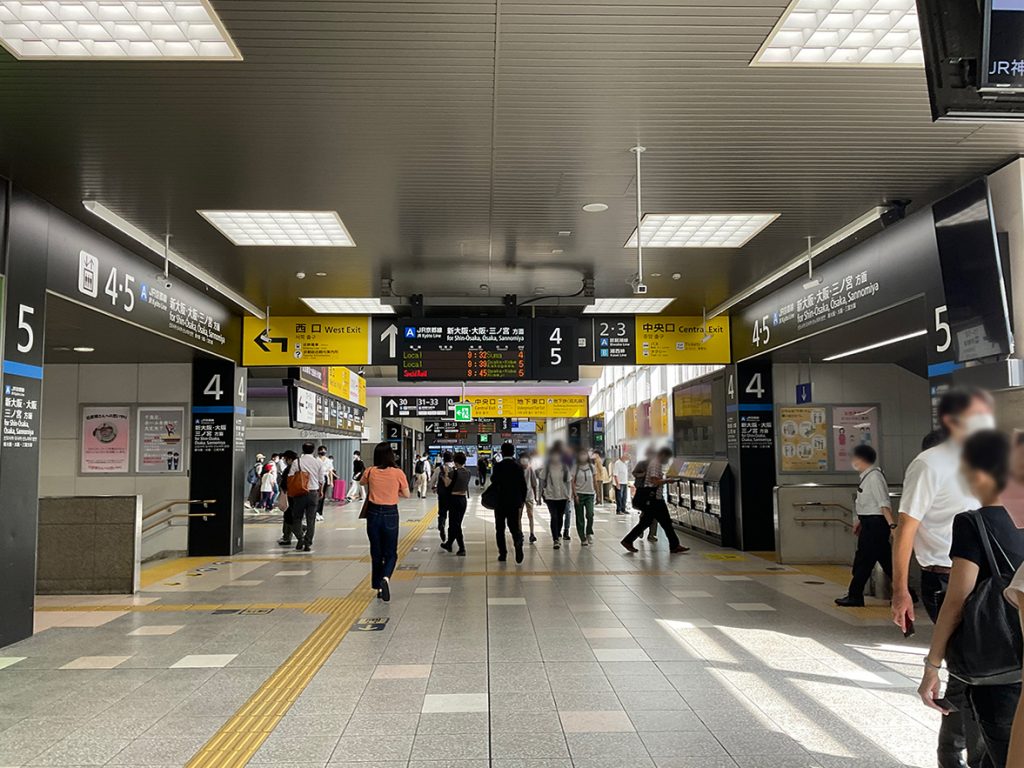
Immediately to your right as you leave the Shinkansen concourse from the “Transfer to JR Lines (Central Transfer) exit” are platforms 8, 9, and 10, which are for the JR Nara Line. The Nara Line goes to Fushimi Inari (nearest to Inari Station) and Uji, and also to a transfer to the Keihan Line.
Tip 4: The Sagano Line (San-in Line) that goes to Arashiyama is next to the longest train platform in Japan
The Sagano Line (San-in Line), on which trains depart from platforms 30 and up, goes in the direction of Saga-Arashiyama Station. However, these platforms are a bit far away from those for other lines.
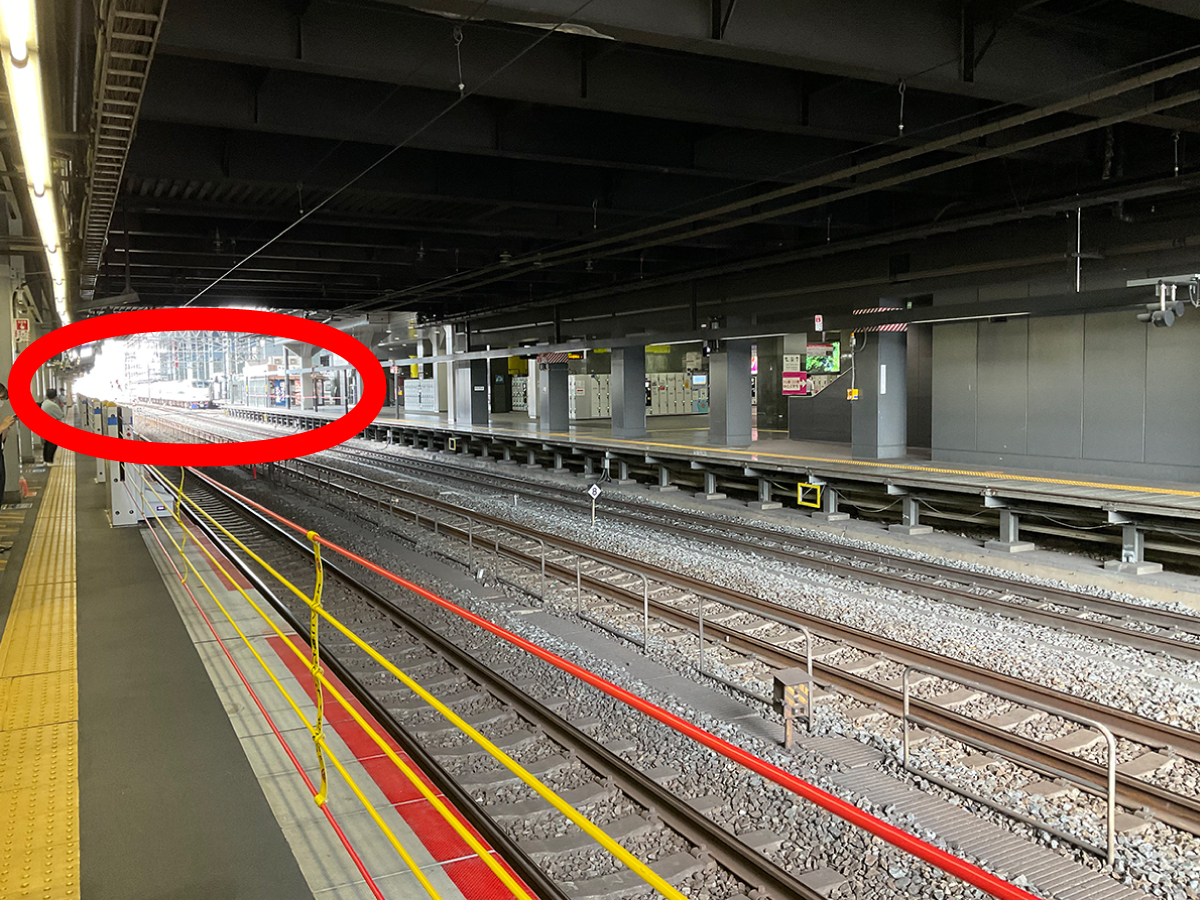
The Limited Express Haruka at Platform 30 is faintly visible. This is fitting, because the word “Haruka” can also mean “far away” in Japanese.
Kyoto Station is home to the longest train platform in Japan, with a length totaling 558 meters. The deal is that Platform 0 is connected to Platform 30, and if you’re looking for the Sagano Line (San-in Line), those trains are on platforms 31, 32, and 33, which are right next to Platform 30. Compared to the other platforms, they’re a lot farther away! It seems like you’ll never get there no matter how far you go, which can be disheartening. But you’ll be okay. Just keep making your way toward the platforms in the 30s and you’ll get there.

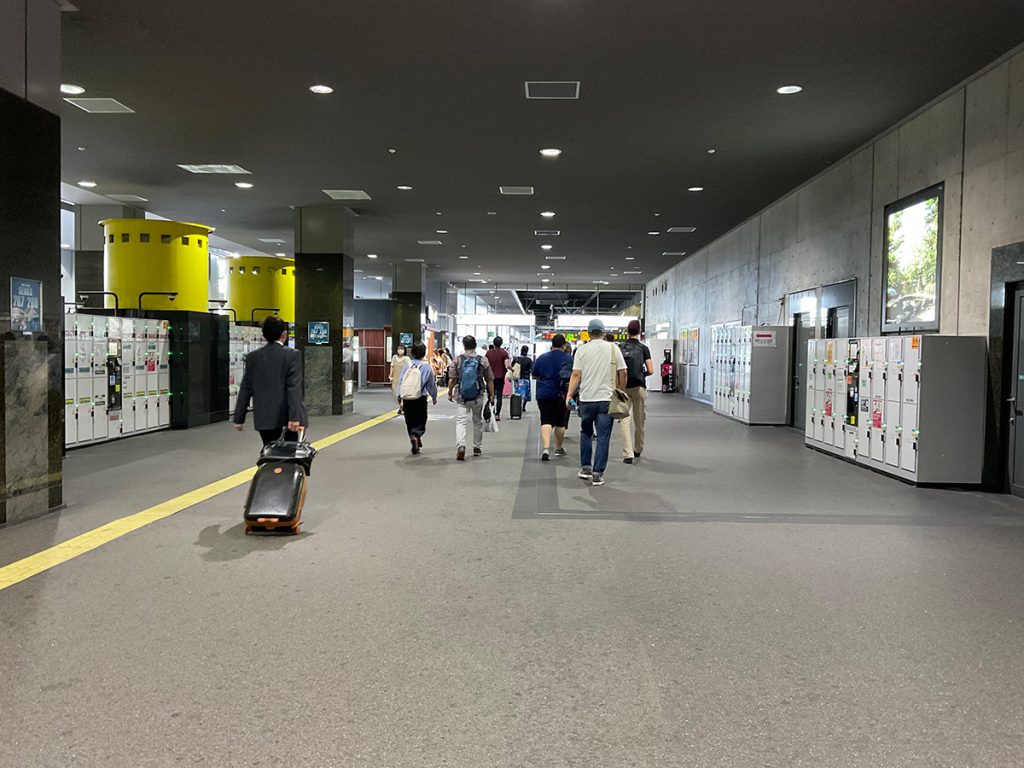
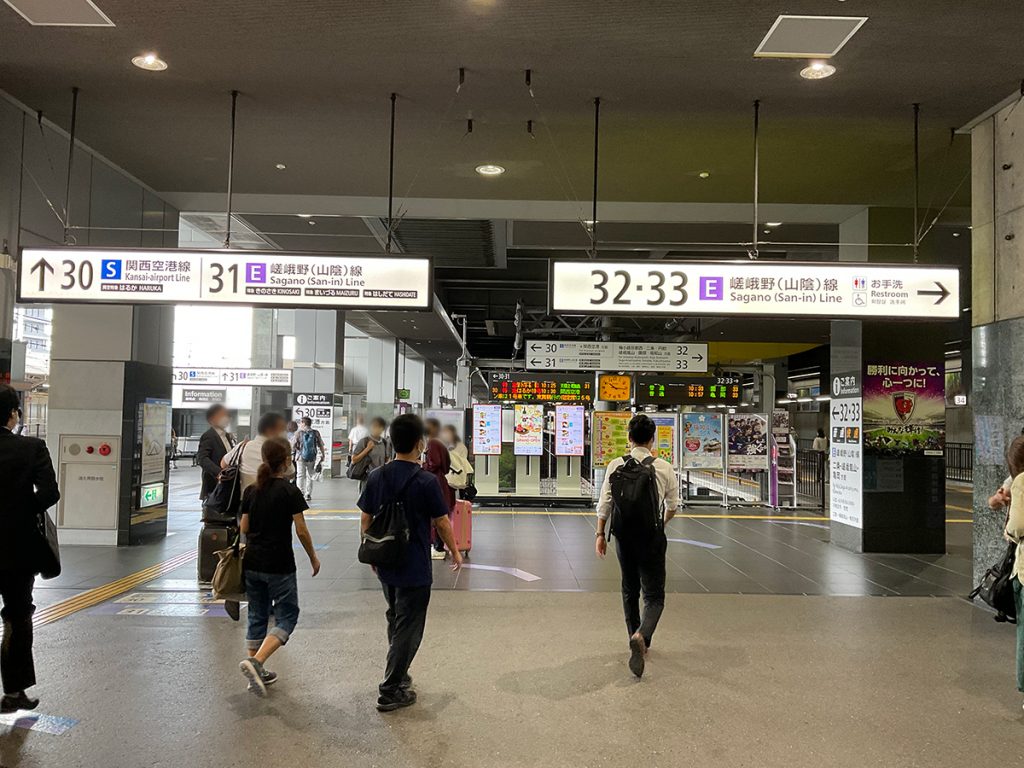

Look for the yellow ceiling.
Lastly, if you want to go to Toji Temple or the Nara and Ise-Shima areas, take the Kintetsu Line. From the Shinkansen concourse, go out through the “Shinkansen Central Exit” and you’ll see the Kintetsu boarding area right in front of you. From local JR lines, go out through the “West Exit” and then go left.
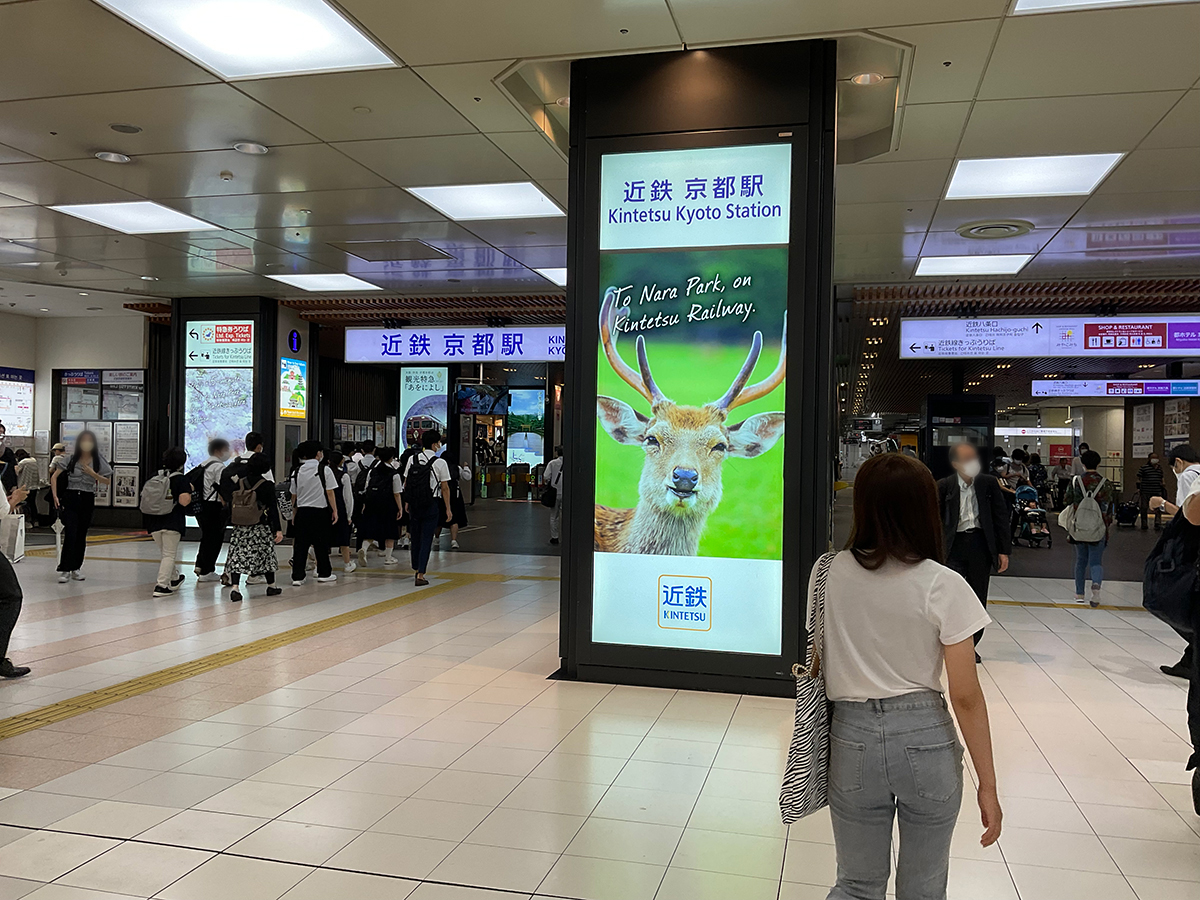
Deer greet you upon your arrival.
Transferring to the Subway
There are a lot of different ways to get from the Shinkansen to the Subway Karasuma Line, but here are three relatively straightforward routes you can take.
(1) Via the “Shinkansen Hachijo Exit”
(2) Via the “Hachijo East Exit”
(3) Via the “Underground East Exit”
Routes (1) and (2) take you through the south side of Kyoto Station, while Route (3) takes you north.
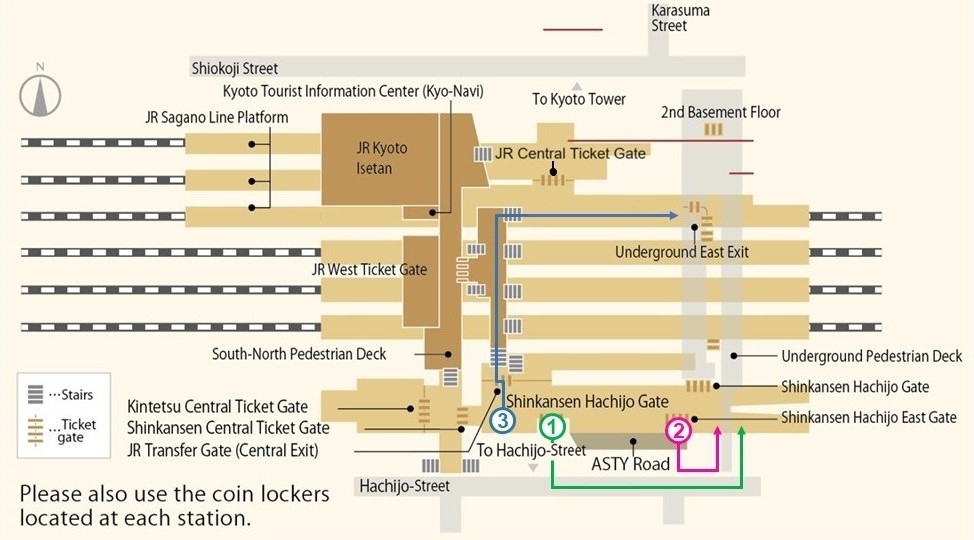
Route (1): Take the escalator, etc. down from the Shinkansen concourse, go out through the Shinkansen Hachijo Exit and go left, turn left at the fast food restaurant, and then head underground.
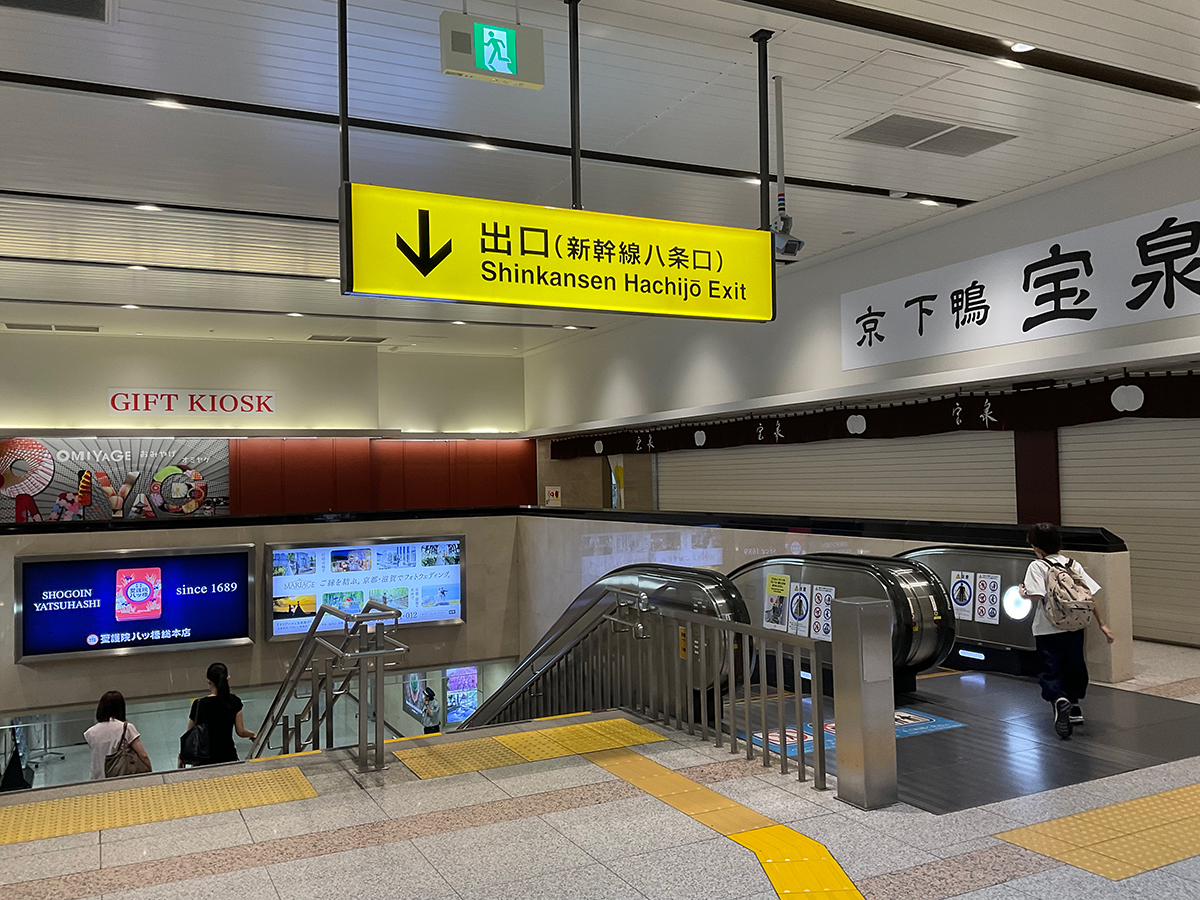

Route (2): Go out through the Hachijo East Exit at the back of the Shinkansen concourse and go left, turn left at the fast food restaurant, and then head underground.
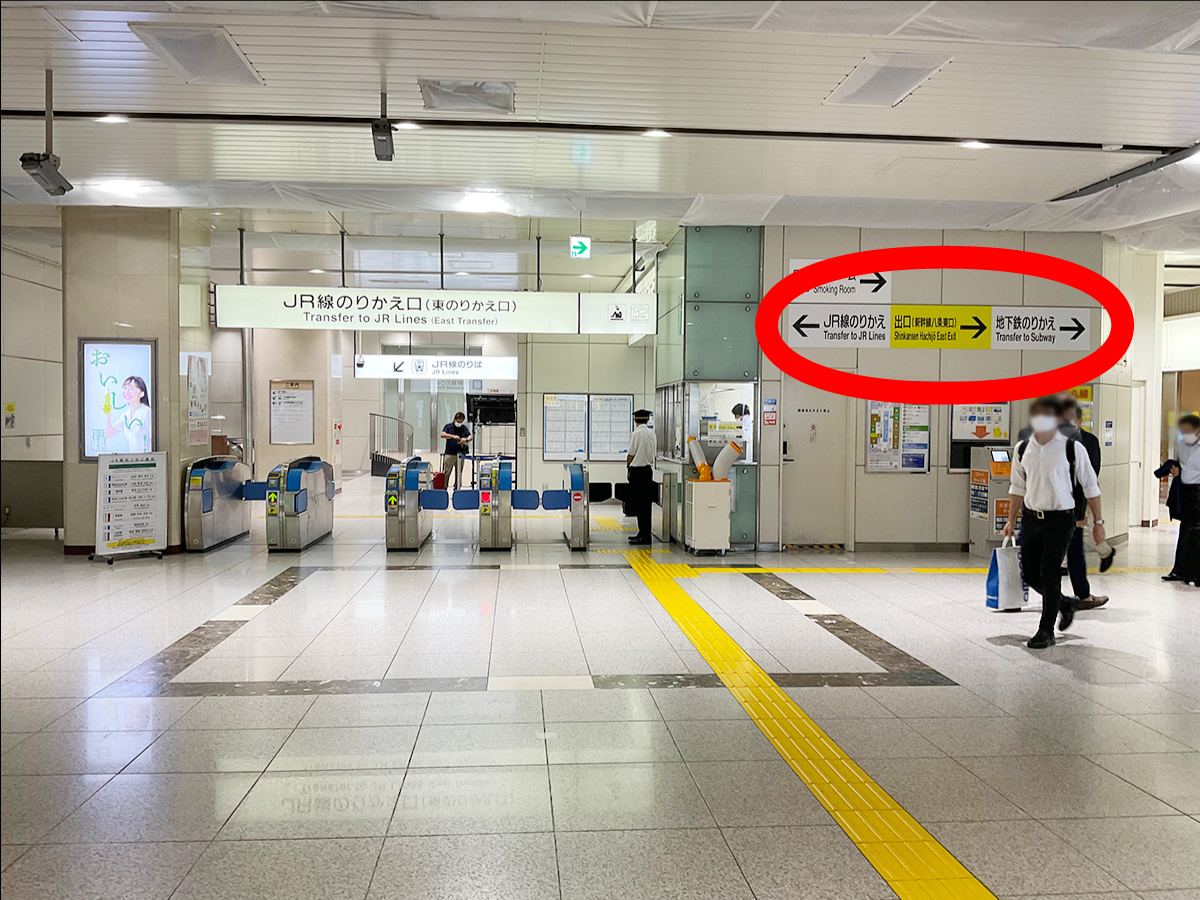

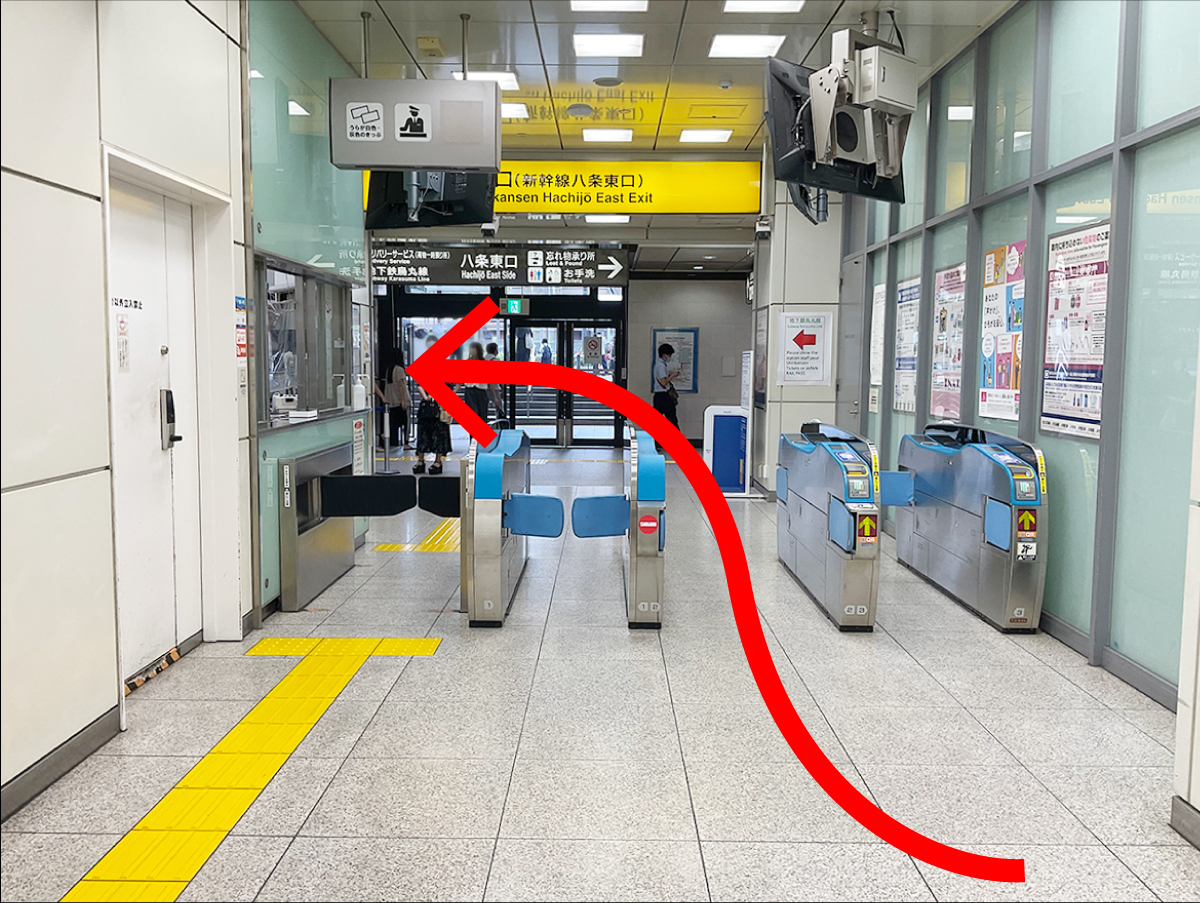
The paths of routes (1) and (2) converge midway, with both taking you to the “South Ticket Gate” of Subway Karasuma Line Kyoto Station. 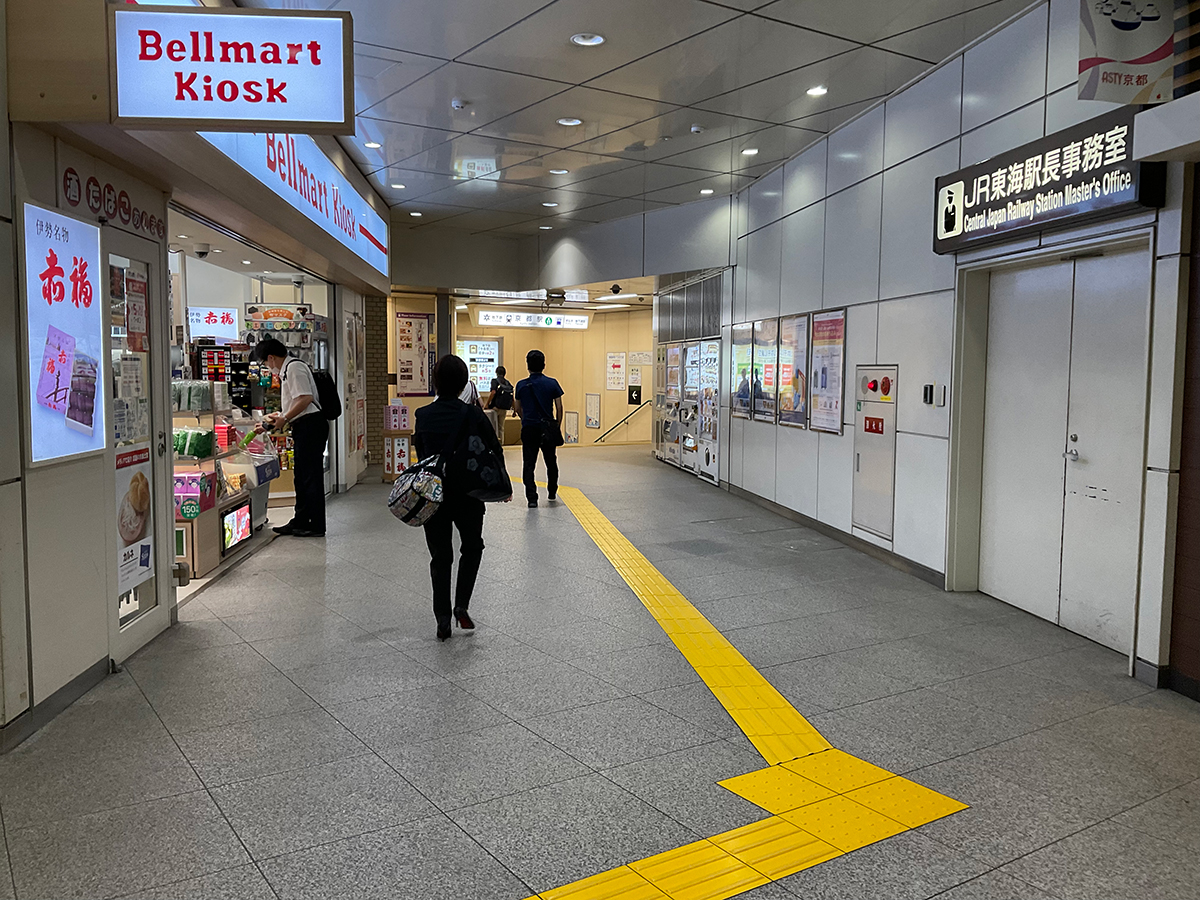
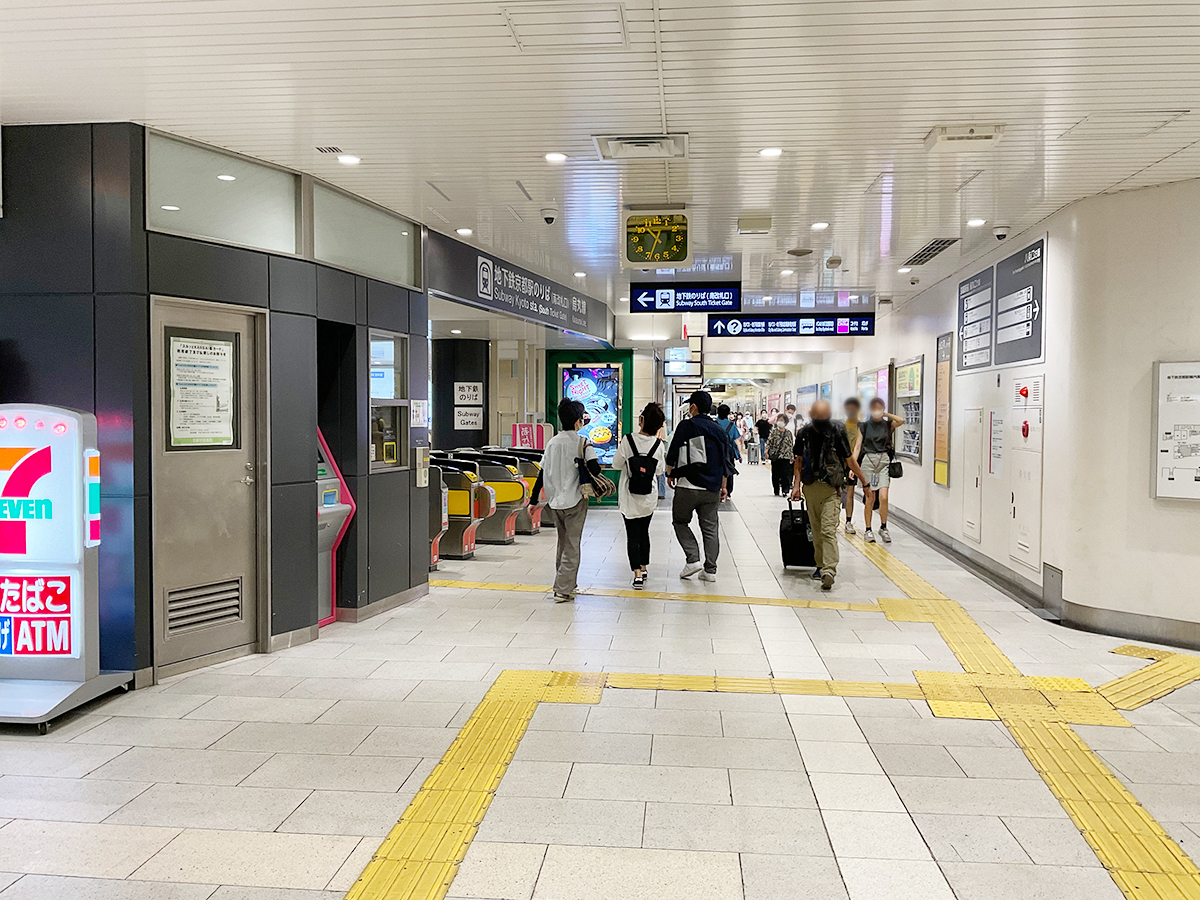
Since these two routes are relatively narrow and have few escalators or elevators, Route (3) below is recommended for those with large luggage and elderly travelers.
Route (3) takes you to the “Underground East Exit.”
Make your way through the passageway inside the ticket gates to the “Underground East Exit”. Along the way you’ll see the “West Exit Gate”, but this is not what you’re looking for. The openness of the area and the flow of people may make you want to go in that direction, but make sure to pass it by. In front of the “West Exit Gate”, there will be a sign directing you to the subway, so follow that sign and head north along the passageway.


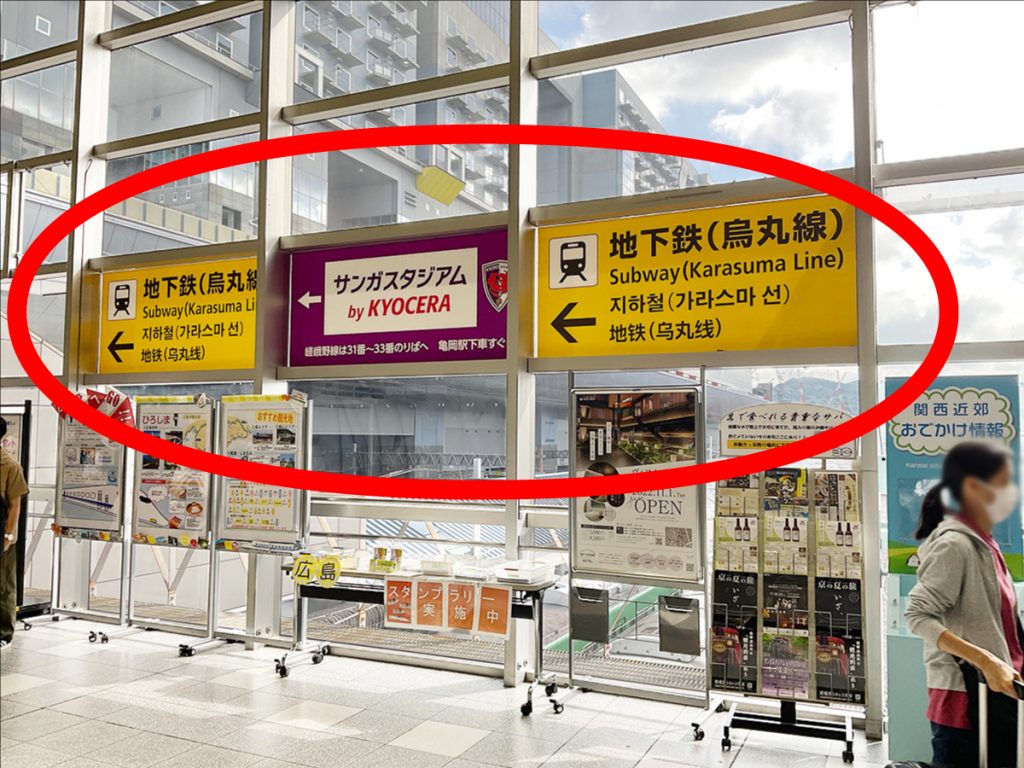
At the end of the passageway, turn right, then go down the escalator toward the “Central Ticket Gate”, i.e. the “Central Exit”. If you can see Kyoto Tower through the glass, then you’re going the right way. Don’t go out through the ticket gate, but instead follow the signs to the “Underground East Exit”, which is the entrance used for transferring to the Subway Karasuma Line underground.
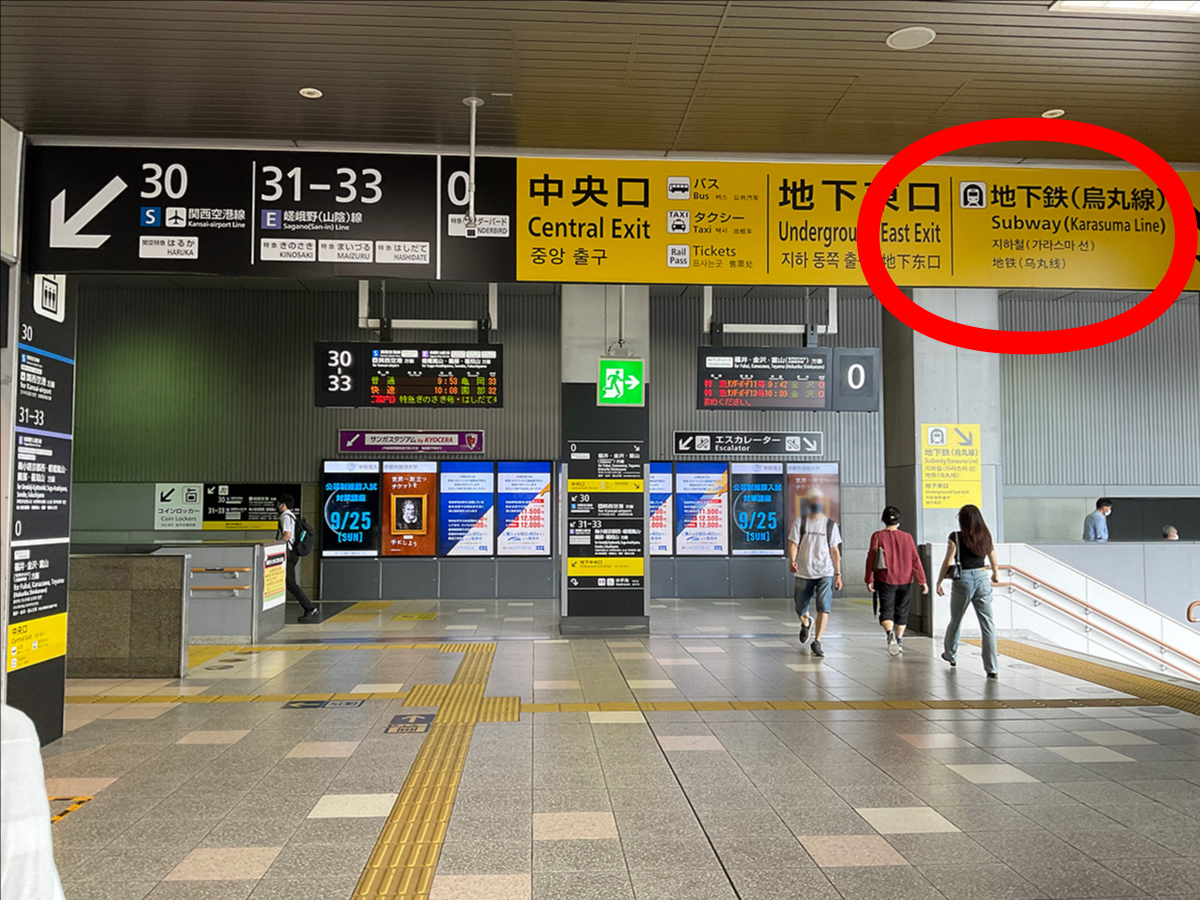
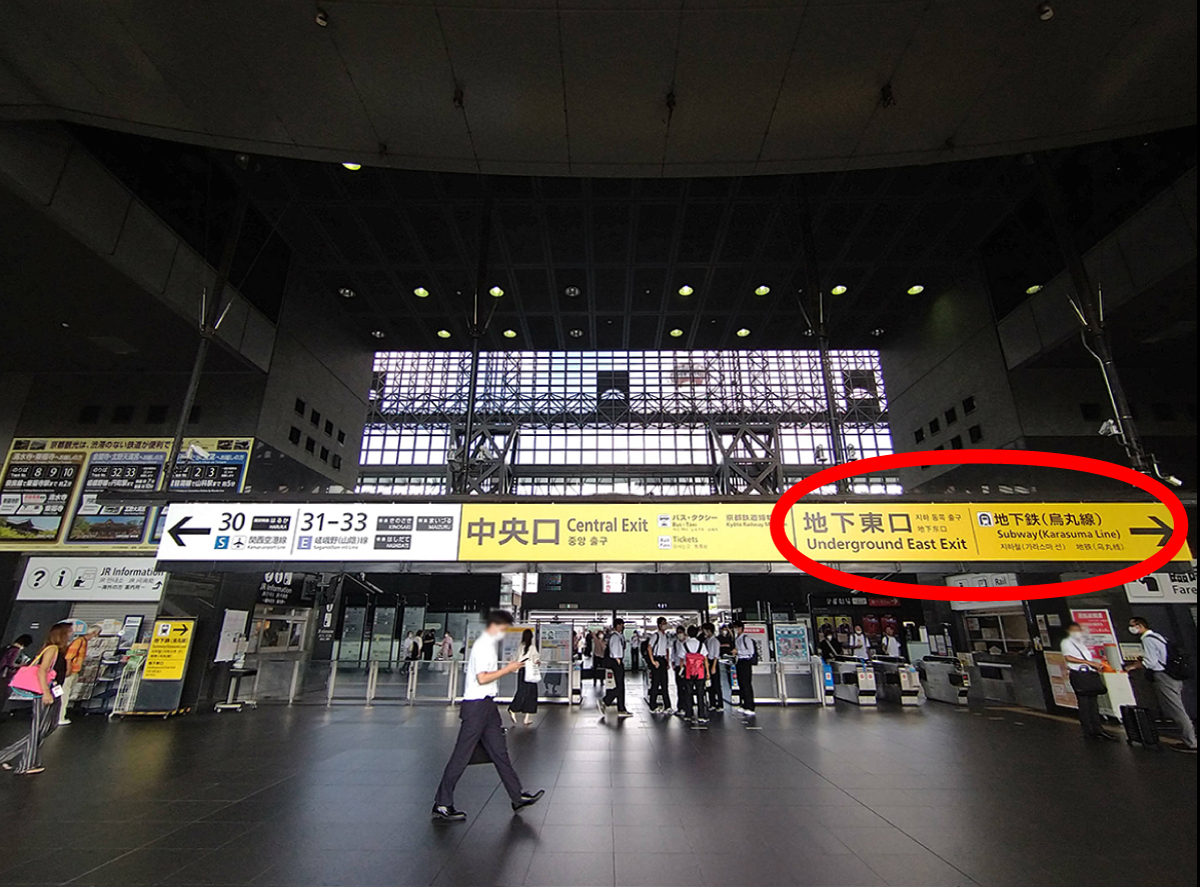
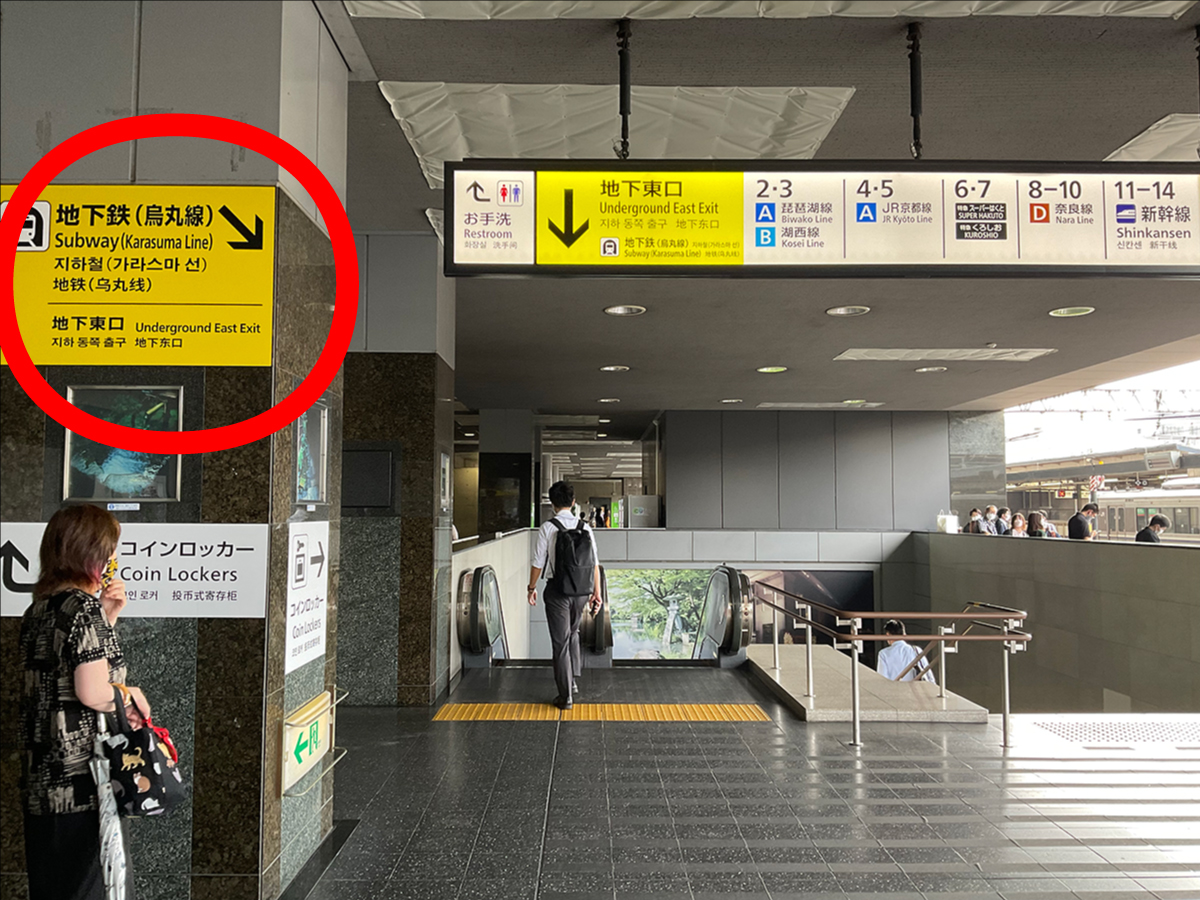
And there you have it, our recommended routes for transferring from the Shinkansen to the subway.
Tip 5: The subway is underground!
The sheer size of Kyoto Station and the number of people in it can make it difficult to know which floor you’re on and whether or not you’re above or below ground. In times like this, what you need to remember is that “the subway is underground”! Especially if you come to Kyoto station via a local train, there are stairs leading underground from each platform, so if you see stairs going up and stairs going down, always take the downward stairs for easier access. If you head out from the Underground Exit, you’ll see the subway’s “Central 1 Ticket Gate” and “Central 2 Ticket Gate” close by. This is also a shorter way to get to the subway station via the connecting passageway inside the ticket gates, rather than going out of the ticket gates and looking for the subway.
Where are the Bus and Taxi Boarding Areas? (Bus & Taxi Info)
Since Kyoto lacks an intricate train or subway system like those in Tokyo or Osaka, utilizing a combination of trains and buses is the best method of travel for sightseeing in the area.
The bus boarding area is right in front of the “Central Exit” of Kyoto Station. You’ll find it right at the foot of Kyoto Tower. Look for the whitish roof that has a curved shape. There is also a bus boarding area at the “Hachijo Exit”, but most of the buses there are expressway buses, airport buses, or shuttle buses that go to and from hotels.
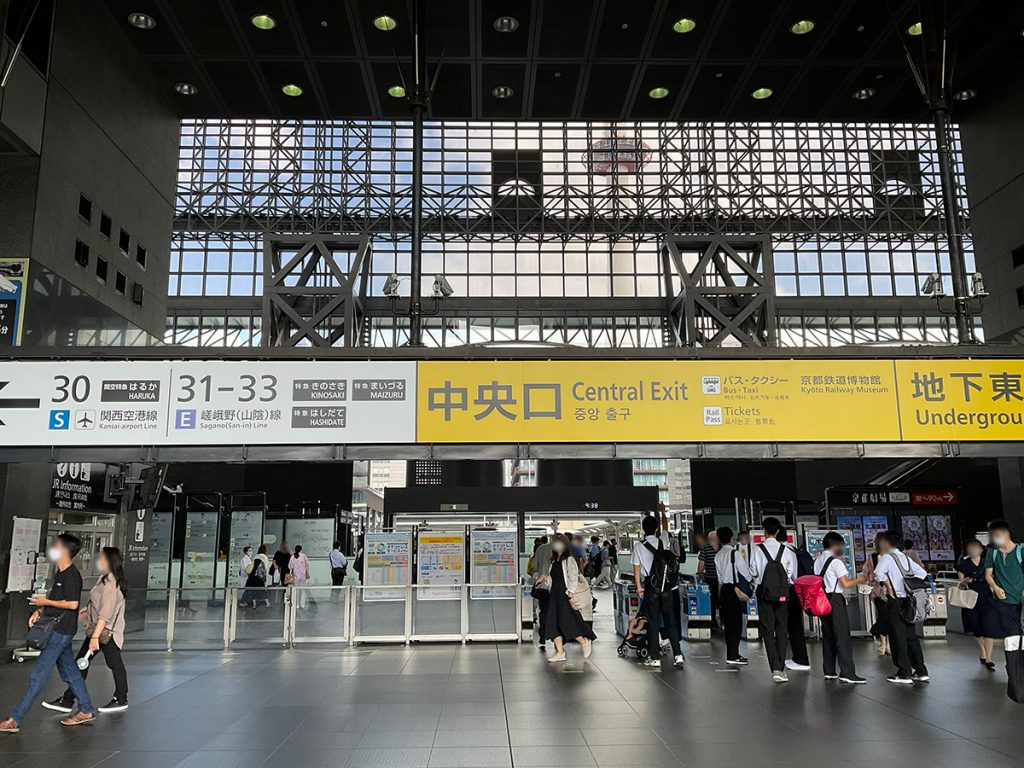
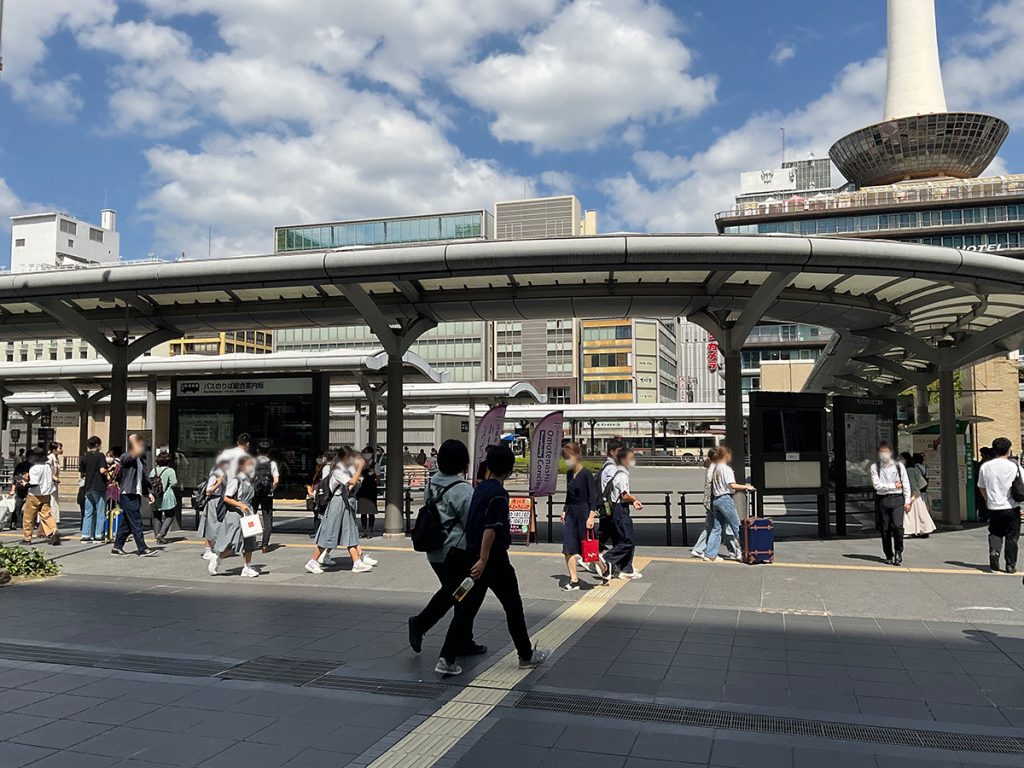
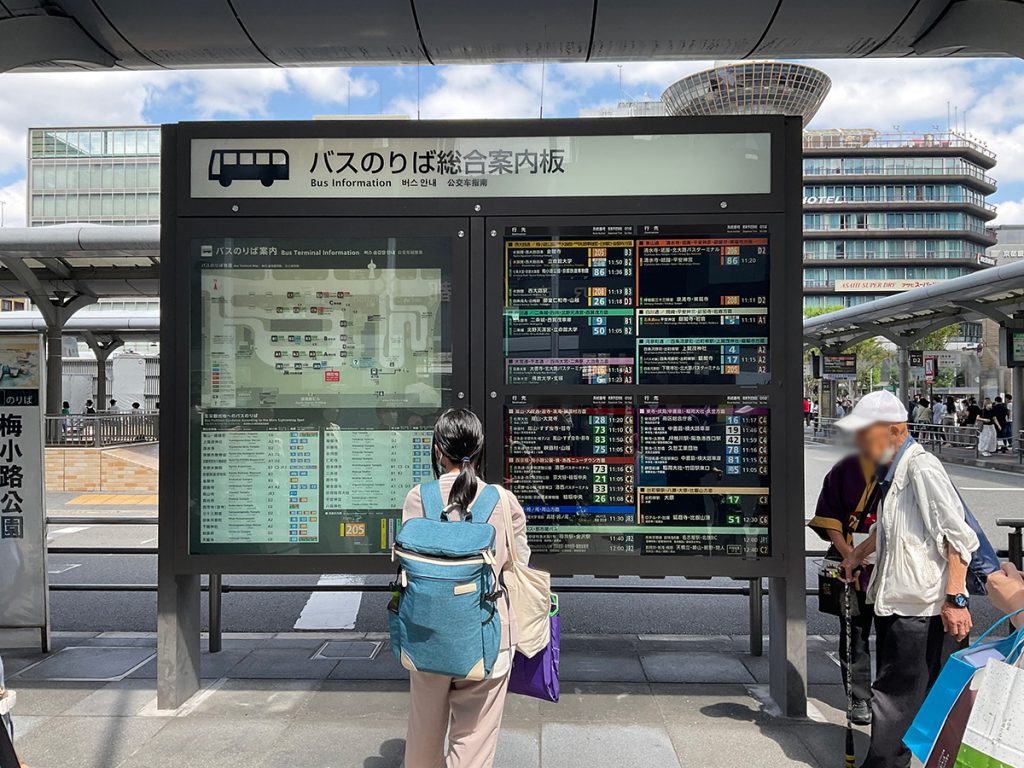

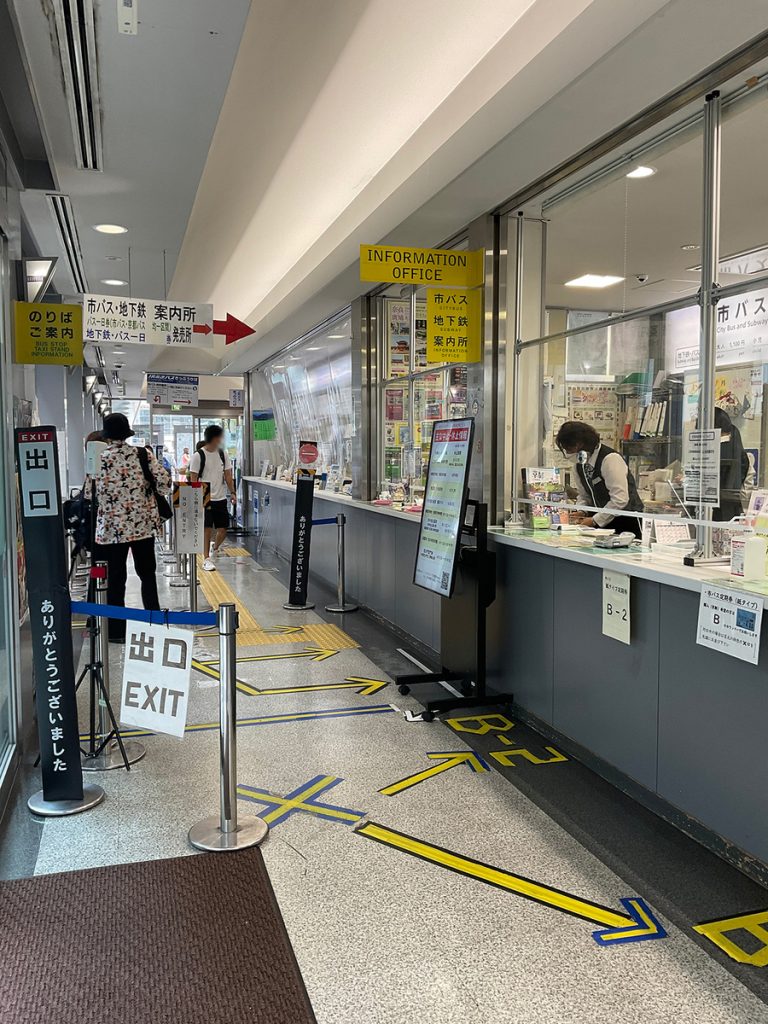
There is also an information center for City Buses and subway lines in the bus ticket center near the bus boarding area’s general information map. If you’re not sure which route you need to take, you can ask here.
Tip 6: Use your one-day ticket wisely!
Buses to popular areas such as Gion and Kiyomizu Temple always have long lines. If you want to avoid the crowds and traffic, a combination of trains and buses is the way to go. This is where the one-day ticket comes in.
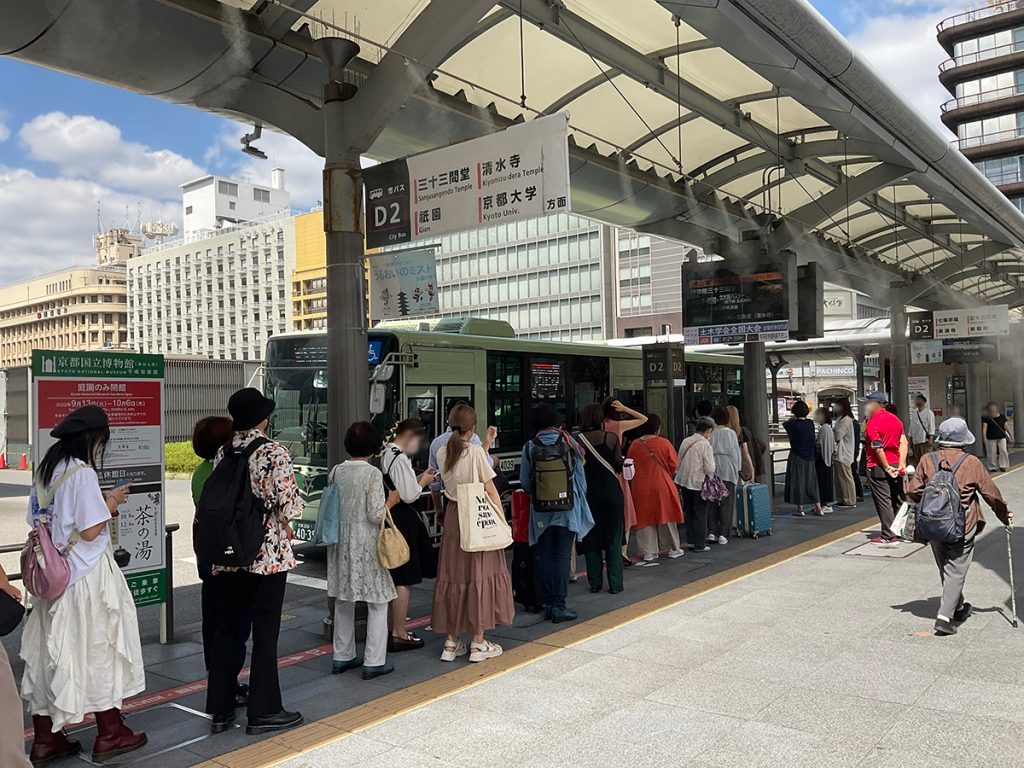

In particular, the “Subway & Bus 1-Day Pass” lets you ride the subway and City Bus as many times as you want on the day you use it (some routes are not available). Since you can use it as many times as you want, you can enjoy stress-free travel when sightseeing in Kyoto without needing to have change ready at various places or keep track of your IC card balance.

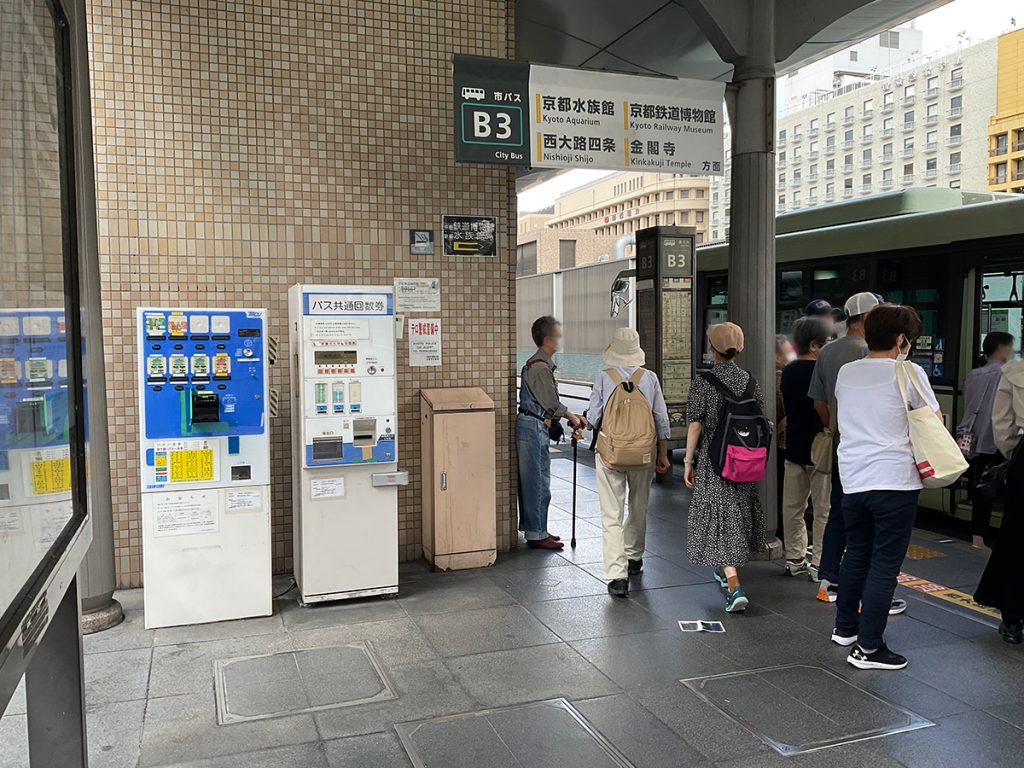
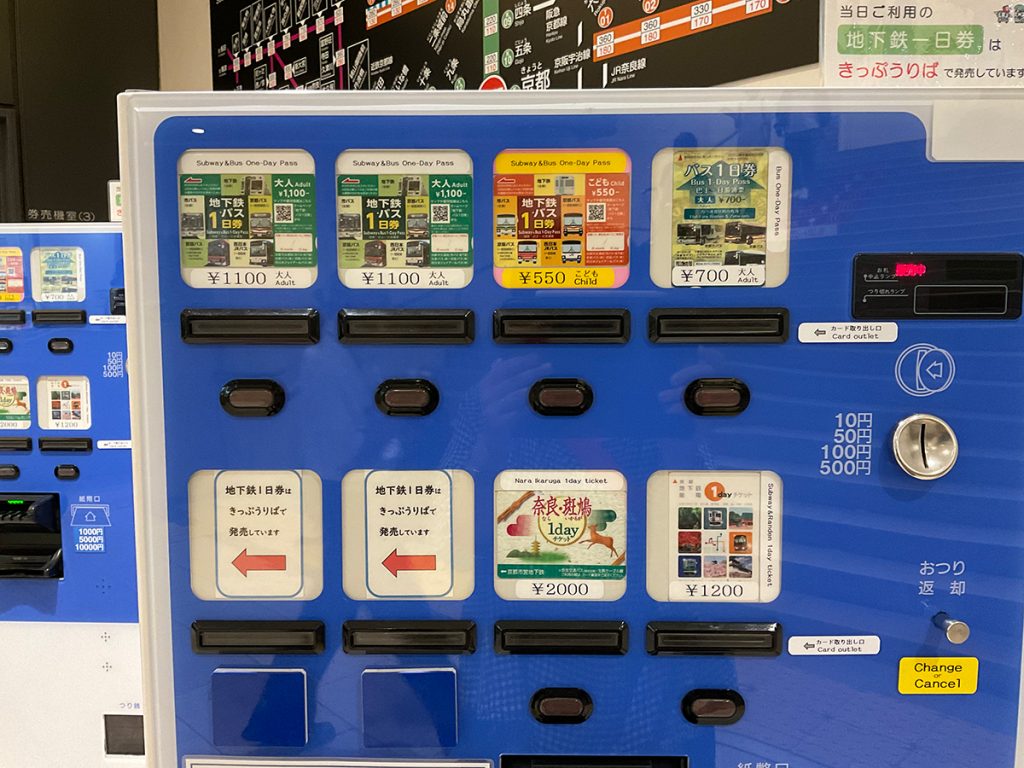
The “Subway & Bus 1-Day Pass” is available at the “Kyoto Tourist Information Center (Kyo-Navi)” located on the 2nd floor of the Kyoto Station Building in the north-south passageway (outside the ticket gates), the Bus Information Center, and from vending machines located at bus stops and subway stations. The price is 1,100 yen for adults and 550 yen for children.
Boarding points for taxis can be found in front of Hotel Granvia at the “Central Exit” on the north side of Kyoto Station, as well as on the south side at the “Hachijo Exit”. Use the one that is more convenient for reaching your destination.
What Lines Don’t Depart From Kyoto Station? (Other Railways)
While Kyoto Station is considered the gateway to Kyoto, there are some lines that are not directly connected to the station. The following railways can be reached by train or bus.
▶︎Keihan Railway
From Kyoto Station, take the JR Nara Line and transfer to the Keihan Line at the first stop, “Tofukuji Station.” This line is a convenient way to get to Gion and Demachiyanagi.
▶︎Eizan Railway
From Kyoto Station, take the JR Nara Line, transfer to Keihan Railway at “Tofukuji Station”, and get off at “Demachiyanagi Station”. You can transfer to Eizan Railway at street level to get to Mt. Hiei and Mt. Kurama.
▶︎Hankyu Railway
Take the Subway Karasuma Line and get off at “Shijo Station”, then head to Hankyu “Karasuma Station”, which is directly connected to the subway station via an underground passageway, and take the Hankyu Line. The Hankyu Line takes you to Arashiyama and Katsura, or to Osaka-Umeda.
▶︎Keifuku Railway (Randen)
Take the Kyoto City Bus to “Shijo Omiya Bus Stop”, where you can get on the train at Keifuku Railway “Shijo-Omiya Station”. This line takes you toward Uzumasa and Arashiyama.
▶︎Subway Tozai Line
While the Subway Karasuma Line runs north-to-south, the Subway Tozai Line runs east-to-west. Take the Subway Karasuma Line to “Karasuma Oike Station” and transfer to the Tozai Line. The Tozai Line can take you in the direction of Yamashina and Rokujizo, or to Nijo Castle and Uzumasa Tenjingawa. If you take the local JR line to Yamashina Station or Rokujizo Station, you can transfer to the Subway Tozai Line at those stations as well.onsidered the gateway to Kyoto, there are some lines that are not directly connected to the station. The following railways can be reached by train or bus.
If you want to transfer from the Keihan Line to the JR Sagano Line, we recommend the Station Loop Bus, which runs between Keihan Shichijo Station and JR Umekoji-Kyotonishi Station. This eliminates the need to transfer at Kyoto Station, which will save you some time. The fare is also a reasonable 230 yen.
Hands-Free and Easy♪ Luggage Storage & Shipping Services (Bonus Info)
Even if you use the most comfortable routes from Kyoto Station to get to where you’re going, hauling all that heavy luggage is so tiring…
Taking bulky bags onto a cramped bus can also cause even more congestion.
In times like this, the luggage storage service at Kyoto Station or one of the services that sends your luggage to your accommodation or other destination can make things much easier. Free yourself from your large luggage as soon as you get to Kyoto Station! This will let you reach your destination much more easily.
[Kyoto City Official Website] HANDS FREE KYOTO | Recommendations for Hands-Free Travel
Reviewing the Important Points One More Time
During the time we spent on our coverage of Kyoto Station, we noticed a lot of people asking for directions. It’s definitely true that navigating the crowds while also looking after large luggage, multiple tickets, children and strollers if you’re traveling as a family, isn’t always easy. To help make things a bit easier, here are three ultimate tips that also serve as a review to wrap things up.
(1) You can find the Central Exit, where the tourist-friendly City Bus Terminal is located, by looking for Kyoto Tower.
(2) Be sure not to mix up the Central Exit and the Shinkansen Central Exit.
(3) The subway is underground.
Since you’ve come all this way to Kyoto, we want to make sure you can enjoy your trip smoothly without getting lost or wasting time! We hope these three points can help you. Keep them in mind to get your travels off to a good start at Kyoto Station.
*Route and fare information, etc. are current as of October 2022.
Further Information on Transportation Around Kyoto
Related Articles
How to avoid the crowds while accessing Kiyomizu Temple and Higashiyama Areas
Go to Arashiyama & Sagano smoothly from Kyoto Station by using the Subway and Randen!
Easy and Less Crowded Access to Kinkaku-ji Temple from Kyoto Station
Getting from Kyoto Station to Kiyomizu Temple while Avoiding Heavy Traffic
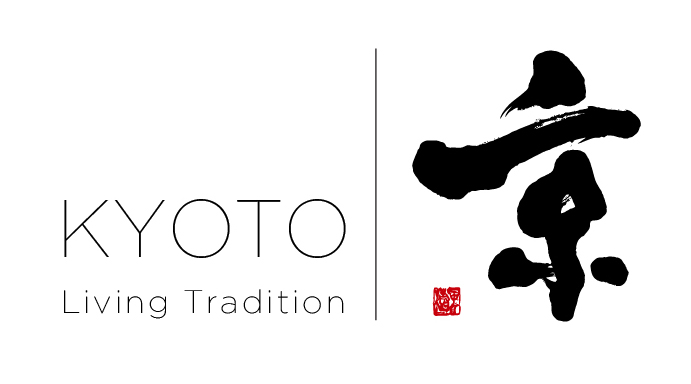
Article Author

